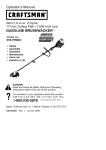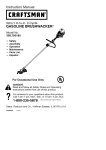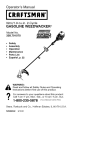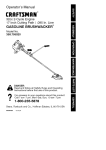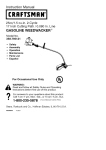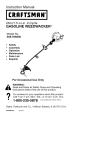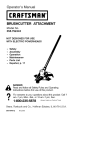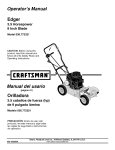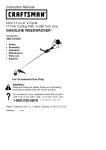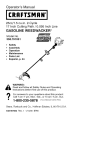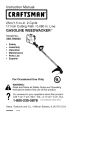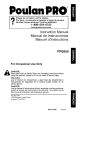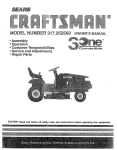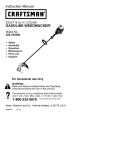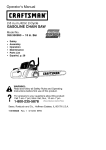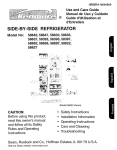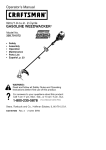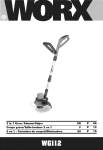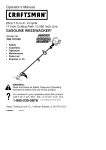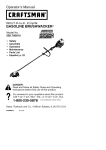Download Craftsman 358.7958 Trimmer User Manual
Transcript
Operator's Manual J€:RAFTSMA#°J 32cc/1.9 cu.in. 2-Cycle GASOLINE BRUSHWAOKER ® Model No. 358.795800 • Safety • Assembly • • Operation Maintenance • Parts List • Espar_ol, p. 22 DANGER: Read and follow all Safety Rules and Operating Instructions before first use of this product. For answers Call 7 am-7 to your questions about this product: pm, Mon.-Sat., or 10 am-7 pm, Sun. 1-800-235-5878 Sears, Roebuck 530164363 and Co., Hoffman 9/12/06 (Hours listed are Central Estates, Time) IL 60179 U.S.A. Warranty Statement Safety Rules Assembly Operation Maintenance Service & Adjustments 2 2 5 9 13 15 TWO YEAR FULL WARRANTY Storage Troubleshooting Table Emissions Statement Parts List Spanish Parts and Ordering ON CRAFTSMAN 16 17 18 20 22 Back Cover ® GAS BRUSHWACKER ® When used and maintained according to the operator's manual, if this product fails due to a defect in material or workmanship within two years from the date of purchase, return it to any Sears store, Sears Service Center, or other Craftsman outlet in the United States for free repair (or replacement if repair proves impossible). This warranty excludes cutting line, blade, spark plug and air filter, which are expendable parts that can wear out from normal use in less than one year. This warranty applies for only 30 days from purchase date if this product is used for commercial or rental purposes. This warranty gives you specific legal rights, and you may also have other rights which vary from state to state. Sears, Roebuck and Co., Hoffman Estates, IL 60179 A_______ dt_WARNING: When using gardening appliances, basic safety precautions must always be followed to reduce the risk of fire and serious injury. cut. Blade thrust can cause amputation of arms or legs. Keep people and animals 50 feet (15 meters) away. DANGER: This power tool can be dangerous! This unit can cause serious injury including amputation or blindness to the operator and others, The warnings and safety instructions in this manual must be followed to provide reasonable safety and efficiency in using the unit, The operator is responsible for following the warnings and instructions in this manual and on the unit. Read the entire operator's manual before assembling and using the unit! Restrict the use of this unit to persons who read, understand, and follow the warnings and instructions in this manual and on the unit, Never allow children to operate this unit, ,_WARNING: Trimmer line can throw objects violently. You and others can be blinded or injured. Wear safety glasses and leg protection. Always use: • Hearing protection • Eye protection • Head protection ALWAYS WEAR: Eye _ Protection 119 • • Leg Guards Boots _ INSTRUCTION MANUAL DANGER: SAFETY ON THE '_kWARNING: INFORMATION UNIT Hazard zone for thrown objects. Blade/Trimmer line can throw objects violently. Others can be blinded or injured. Keep people and animals 50 feet (15 meters) away. Blade can thrust vio- lently away from material it does not 2 Hazard Zone I,l _WARNING: Do not use trimmer head as a fastening device for the blade. ,_WARNING: The blade continues to spin after the throttle is released or, engine is turned off. The coasting blade can throw objects or seriously cut if accidentally touched. Stop the blade by contacting the right hand side of the coasting blade with material already cut. Stop coasting blade by contact with cut material. ® OPERATOR SAFETY • Dress properly. Always wear safety glasses or similar eye protection when operating, or performing maintenance on your unit. (Safety glasses are available.) Eye protection should be marked Z87. • Always wear face or dust mask if operation is dusty. • Always wear hea W, long pants, long sleeves, boots, and gloves. Wearing safety leg guards is recommended. • Always wear foot protection. Do not go barefoot or wear sandals. • Secure hair above shoulder length. Secure or remove loose clothing and jewelry or clothing with loosely hanging ties, straps, tassels, etc. They can be caught in moving parts. • Being fully covered also helps protect you from debris and pieces of toxic plants thrown by spinning line/blade. • Stay Alert. Do not operate unit when you are tired, ill, upset or under influence of alcohol, drugs, or medication. Watch what you are doing; use common sense. • Wear hearing protection. • Never start or run the engine inside a closed room or building. Breathing exhaust fumes can kill. • Keep handles free of oil and fuel. • Always use the handlebar and a properly adjusted shoulder strap with a blade (see ASSEMBLY). UNIT/MAINTENANCE SAFETY A0&WARNING: Stop unit and disconnect the spark plug before performing maintenance (except carburetor adjustments). • Look for and replace damaged or loose parts before each use. Look for and repair fuel leaks before use. Keep unit in good working condition. • Throw away blades that are bent, warped, cracked, broken, or damaged in any other way. Replace trimmer head parts that are cracked, chipped, broken, or damaged in any other way before using the unit. • Maintain unit according to recommended procedures. Keep blade sharp. Keep cutting line at the proper length. • Use only Craftsman _'R' brand replacement line. Never use wire, rope, string, etc. • Install required shield properly before using the unit. Use the metal shield for all metal blade use. Use the plastic shield for all line trimmer use. • Use only specified blade or trimmer head; make sure it is properly installed and securely fastened. • Never startengine withclutch • Keep all parts of your body away from blade, trimmer head, and mufshroud removed. Theclutch canfly offandcause serious injury. fler when engine is running. A hot • Besureblade ortrimmer head stops muffler car cause serious burns. turning whenengine idles. • Cut from your left to your right. • Make carburetor adjustments with Cutting on right side of the shield will thelower endsupported toprevent throw debris away from the operator. blade ortrimmer linefromcontacting• Use only in daylight or good artificial anyobject. Holdunitbyhand; donot light. usetheshoulder strap forsupport. • Use only for jobs explained in this • Keep others away whenmaking car- manual. TRANSPORTING AND STORAGE buretor adustments. • Useonlyrecommended Craftsman '!:' • Stop tile unit before carrying. accessories andreplacement parts. • Keep muffler away from your body. • Have allmaintenance andservice not • Allow the engine to cool and secure explained inthismanual performed by the unit before storing or transportyourSears Service Center. ing it in a vehicle. FUEL SAFETY • Mix and pour fuel outdoors. • Keep away from sparks or flames. • Use a container approved for fuel. • Do not smoke or allow smoking near fuel or the unit or while using the unit. • Avoid spilling fuel or oil. Wipe up all fuel spills before starting engine. • Move at least 10 feet (3 meters) away from fueling site before starting engine. • Stop engine and allow it to cool before removing fuel cap. • Empty the fuel tank before storing or transporting the unit. Use up fuel left in the carburetor by starting the engine and letting it run until it stops. • Store unit and fuel in area where fuel vapors cannot reach sparks or open flames from water heaters, electric motors or switches, furnaces, etc. • Always store gasoline in a container approved for flammable liquids. CUTTING SAFETY WARNING: Inspect the area to be cut before each use. Remove objects (rocks, broken glass, nails, wire, string, etc.) which can be thrown or become entangled in the blade or trimmer head. • Keep others including children, animals, bystanders, and helpers at least 50 feet (15 meters) away. Stop engine immediately if you are approached. • Always keep engine on the righthand side of your body. • Hold the unit firmly with both hands. • Keep firm footing and balance. Do not overreach. • Keep blade or trimmer head below waist level. Do not raise engine above your waist. • Empty the fuel tank before storing or transporting the unit. Use up fuel left in the carburetor by starting the engine and letting it run until it stops. • Store unit so the blade or line limiter blade cannot accidentally cause injury. The unit can be hung by the shaft. • Store unit out of reach of children. This unit is not equipped with an antivibration system and is intended for occasional use only. SAFETY NOTICE: Exposure to vibrations through prolonged use of gasoline powered hand tools could cause blood vessel or nerve damage in the fingers, hands, and joints of people prone to circulation disorders or abnormal swellings. Prolonged use in cold weather has been linked to blood vessel damage in otherwise healthy people. If symptoms occur such as numbness, pain, loss of strength, change in skin color or texture, or loss of feeling in the fingers, hands, or joints, discontinue the use of this tool and seek medical attention. An anti-vibration system does not guarantee the avoidance of these problems. Users who operate power tools on a continual and regular basis must monitor closely their physical condition and the condition of this tool. SPECIAL NOTICE: This unit is equipped with a temperature limiting muffler and spark arresting screen which meets the requirements of California Codes 4442 and 4443. All U.S. forest land and the states of California, Idaho, Maine, Minnesota, New Jersey, Oregon, and Washington require by law that many internal combustion engines be equipped with a spark arresting screen. If you operate in a locale where such regulations exist, you are legally responsible formaintaining theoperatingcondition ofthese parts. Failure to dosoisaviolation ofthelaw.Fornormalhomeowner use,themuffler and spark arresting screen willnotrequire anyservice. After 50hours ofuse,we recommend thatyourmuffler beserviced orreplaced byyourSears Service Center. CARTON CONTENTS ningblade. thedecal onthehandlebar. Check carton contents against thefol- 1. Locate Thisdecal includes anarrow. Posilowing list. Model358.795800 tionthehandlebar withthemount• Brushcutter ingbracket attheendofthearrow. 2. Position thebracket cover over the • Cupped washer • Large nutforinstalling blades handlebar. Again make surethe • Hexwrench handlebar isattheendofthearrow. • Handlebar 3. Insert screws andhand tighten • Bracket cover only. Besurethehandlebar is installed correctly; then,tighten • Bracket cover screws (2) • Metal blade shield each screw securely withthehex wrench. • Blade shield screws (4) • 4-Point weedblade --_ Handlebar• _ Screw • 8-Point weedblade • Plastic shield • Wing nut(screwed ontoshield) • Trimmer head(assembled onunit) • Shoulder strap withwarning £-_-__Cover • Container ofline • Container ofoil Mounting _ "_'_"_._ Examine parts fordamage. Donot Bracketusedamaged parts. OFSHOULDER STRAP NOTE: Ifyouneedassistance orfind ASSEMBLY partsmissing ordamaged, call '_WARNING: Proper shoulder 1-800-235-5878. strap and handlebar adjustments must Itisnormal forthefuelfiltertorattlein be made with the engine completely theempty fueltank. stopped before using unit. Finding fueloroilresidue onmuffler is 1. Insert your right arm and head normal duetocarburetor adjustments through the shoulder strap and alandtesting donebythemanufacturer. low it to rest on your left shoulder. ASSEMBLY Make sure the danger sign is on your back and the hook is to the _WARNING:Always stopunit right side of your waist. anddisconnect spark plugbefore per- NOTE: A one-half twist is built in the forming anyassembly procedures. shoulder strap to allow the strap to rest flat on the shoulder. WARNING: Ifreceived as2. Adjust the strap, allowing the hook sembled, repeat allsteps toensure to be about 6 inches below the yourunitisproperly assembled andall waist. fasteners aresecure. 3. Fasten the strap hook to the clamp TOOLS REQUIRED located between the trigger handle • HexWrench (provided) and the handlebar clamp base and lift the tool to the operating position. • Adjustable Wrench 4. Try on shoulder strap and adjust • Phillips Screwdriver for fit and balance before starting ATTACHING THEHANDLEBAR the engine or beginning a cutting DANGER: Toavoid serious injuoperation. ry,thebarrier portion ofthehandlebar NOTE: It may be necessary to relomust beinstalled asshown toprovide a cate the shoulder strap clamp on the barrier between operator andthespin- shaft for proper balancing of unit. TO RELOCATE SHOULDER STRAP CLAMP: 1. Loosen and remove both clamp screws. 2. Place the upper shoulder strap clamp over the shaft. 3. Position the lower shoulder strap clamp under the shaft and align the upper and lower clamp screw holes. Upper Shoulder Clamp Lower Shoulder Strap Clamp 4. 5. CONFIGURING YOUR UNIT You can configure your unit using a cutting head for grass and light weeds, or a weed blade for cutting grass, weeds, and brush up to 1/2 inch in diameter. To assemble your unit, go to the section for the desired configuration and follow the instructions. ASSEMBLY INFORMATION TRIMMER HEAD ::_ TRIMMER l Screws Insert two screws into the screw holes. Secure shoulder strap clamp by tightening screws with a hex wrench. HARNESS ADJUSTMENT FOR BALANCE 6 inches below waist 4 -12 inches above ground 30 inches I 30 i NOTE: Remove the blade and metal shield before attaching the plastic shield and trimmer head. To remove blade, align hole in the dust cup with the hole in the side of the gearbox by rotating the dust cup. Insert a small screwdriver into aligned holes. This will keep the shaft from turning while loosening the blade nut. Remove blade nut by turning clockwise. Remove the screwdriver. Remove both washers and blade. To remove metal shield, loosen and remove the four mounting screws. See ATTACHING THE METAL SHIELD and INSTALLATIONOF THE METAL BLADE for illustrations. Be sure to store all parts and instructions for future use. INSTALLATION OF THE CUTTING HEAD (if not already installed) NOTE: Before installing the trimmer head, make sure the dust cup and retaining washer are positioned on the shaft of the gearbox. The retaining washer must be positioned with the raised section toward the gearbox. 1. Align hole in the dust cup with the hole in the side of the gearbox by rotating the dust cup. 2. Insert a small screwdriver into aligned holes. This will keep the shaft from turning while tightening trimmer head. Screwier _ 3. Whileholding thescrewdriver in in the side of the gearbox by rotating position, thread trimmer headonto the dust cup. Insert a small screwdriver theshaft byturning counterclock- into aligned holes. This will keep the wise. Only tighten hand tight! shaft from turning while loosening the trimmer head. Remove the trimmer head by turning clockwise. Remove the screwdriver. To remove the plastic shield, loosen and remove wing nut. Pivot shield to release bracket from slot. See iNSTALLATION OF THE CUq-i-ING HEAD and ATTACHING THE PLASTIC SHIELD for illustrations. Be sure to store all parts and instructions for future use. Never use the trimmer head with the metal blade installed. ATTACHING THE METAL SHIELD .,t,_-- Gearbox I _ i_).,=_ Cutting Head I Dust Cup Retaining Washer ,_WARNING: 4. Remove the screwdriver. ATTACHING THE PLASTIC _WARNING: The metal shield must be properly installed on the tool anytime the tool is used with a blade. The forward tip of the metal shield helps to reduce the occurrence of blade thrust which can cause serious injury such as amputation to the operator or bystanders. Failure to install the shield in the position shown can result in serious injury to the operator. The length of the shield must be aligned with the length of the shaft. 1. Place the metal shield under the gearbox, and align the screw holes. SHIELD The shield must be properly installed. The shield provides partial protection from the risk of thrown objects to the operator and others and is equipped with a line limiter blade which cuts excess line to the proper length. The line limiter blade (on underside of shield) is sharp and can cut you. 1. Remove wing nut from shield. 2. Insert bracket into slot on shield. 3. Pivot shield until bolt passes through hole in bracket. 4. Tighten the wing nut securely. , Gearbox Shield s_earbox_ ASSEMBLY BLADES INFORMATION - WEED 2. Insert and thread the 4 mounting screws through the holes of the gearbox and the metal shield. Tighten evenly and securely with the hex wrench provided. INSTALLATION OF THE METAL BLADE _WEED BLADES _, WARNING: Wear protective gloves when handling or performing maintenance on the blade to avoid injury. The blade is sharp and can cut you even when it is not moving. NOTE: Remove the trimmer head and plastic shield before attaching the metal shield and installing one of the weed blades. To remove the trimmer head, align hole in the dust cup with the hole ,_;_,WARNING: Do not use any blades, or fastening hardware other than the washers and nuts shown in the following illustrations. These parts must be provided by Sears, and installed as 7 shown below. Failure touseproper parts cancause theblade toflyoffand seriously hurtyouorothers. NOTE: Thedustcupandretaining washer arelocated onthegearbox shaft andnotintheparts bag.Allother fasteners mentioned inthefollowing assembly steps areintheparts bag. 1. Remove theretaining washer from thethreaded shaft ofthegearbox. Leave thedustcupontheshaft. 2. Install theblade andtheretaining washer overthethreaded shaft. 3. Make suretheraised partofthe retaining washer isfacing the gearbox andtheraised areafits intotheholeinthecenter ofthe blade. 4. Slide theblade andretaining washerontotheshaft ofthegearbox. NOTE: When installing 8-point weedblade, ensure sideofblade withdecal isfacing gearbox and points ofblade willrotate counterclockwise (see illustration). 8-POINT BLADE DECAL SIDE OF BLADE MUST FACE GEARBOX 5. 6. Place the cupped washer onto the shaft. Make sure the cupped side of the washer is toward the blade. Install the blade nut by threading onto the shaft counterclockwise. Gearbox Shield Dust Cup de Retaining Washer _ Cupped Washer _ Nut NOTE: Make sure all parts are in place as illustrated, and the blade is sandwiched between the dust cup and the retaining washer. There should be no space between the blade and the dust cup or the retaining washer. 7. Align hole in dust cup with hole in side of gearbox by rotating the blade. 8. Insert a small screwdriver into aligned holes. This will keep the shaft from turning while tightening the blade nut. Screwdriver _ 9. Tighten blade nut firmly with a wrench while holding screwdriver in position. 10. Remove the screwdriver. 11. Turn blade by hand. If the blade binds against the shield, or appears to be uneven, the blade is not centered, and you must reinstall. NOTE: To remove blade, insert screwdriver into aligned holes. Unthread the nut and remove parts. Be sure to store parts and instructions for future use. KNOW YOUR BRUSHWACKER READ THIS OPERATOR'S MANUAL AND SAFETY RULES BEFORE OPERATING YOUR UNIT. Compare the illustrations with your unit to familiarize yourself with the location of the various controls and adjustments. Save this manual for future reference. Trimmer Handlebar Head Shaft Line Umiter Blade ON/OFF Switch Starter Handle Primer Bulb Blade Throttle Trigger Choke Lever Muffler ON/OFF SWITCH The ON/OFF SWITCH is used to stop the engine. Move the switch to the OFF position to stop the engine. PRIMER BULB The PRIMER BULB removes air from the carburetor and fuel lines and fills them with fuel. This allows you to start the engine with fewer pulls on the starter rope. Activate the primer bulb by pressing it and allowing it to return to its original form= CHOKE BEFORE STARTING contents of this container into 1 gallon of gasoline to achieve the proper fuel mixture. DO NOT USE automotive oil or marine oil. These oils will cause engine damage. When mixing fuel, follow instructions printed on container. Once oil is added to gasoline, shake container momentarily to assure that the fuel is thoroughly mixed. Always read and follow the safety rules relating to fuel before fueling your unit. IMPORTANT Experience indicates that alcohol blended fuels (called gasohol or using ethanol or methanol) can attract moisture which leads to separation and formation of acids during storage. Acidic gas can damage the fuel system of an engine while in storage. To avoid engine problems, empty the fuel system before storage for 30 days _WARNING: ENGINE Be sure to read the fuel information in the safety rules before you begin. If you do not understand the safety rules, do not attempt to fuel your unit. Call 1-800-235-5878. FUELING ENGINE _,WARNING: Remove fuel cap slowly when refueling. This engine is certified to operate on unleaded gasoline. Before operation, gasoline must be mixed with a good quality synthetic 2-cycle air-cooled engine oil. We recommend Craftsman brand synthetic oil. Mix gasoline and oil at a ratio of 40:1. A 40:1 ratio is obtained by mixing 3.2 ounces of oil with 1 gallon of unleaded gasoline. Included with this brushcutter is a 8.2 ounce container of oil. Pour the entire The CHOKE helps to supply fuel to the engine to aid in cold starting. Activate the choke by moving the choke lever to the FULL CHOKE position. After the engine attempts to start, move the choke lever to the HALF CHOKE position. Once engine has started, move the choke lever to the OFF CHOKE position. orlonger. Drain thegastank, startthe engine andletitrununtilthefuellines andcarburetor areempty. Usefresh fuelnextseason. Never useengine orcarburetor clean- Choke erproducts inthefueltankorperma- position decal nentdamage mayoccur. SeetheSTORAGE section foradditionalinformation. HOW TO STOP YOUR UNIT 5. Squeeze • To stop the engine, move the ON/ OFF switch to the OFF position. • If engine does not stop, move choke lever to FULL CHOKE position. ON/OFF Throttle Trigger _ 6. 7. _. HOW TO START YOUR UNIT _WARNING: The trimmer head Choke position decal will turn while starting the engine, Avoid any contact with the muffler. A hot muffler can cause serious burns, STARTING A COLD ENGINE (or a warm engine after running out of fuel) ",1 ,@ 8. ,J;'_ c_;artingPosition t&j @ Choke P Lever Primer Bulb 9. Muffler 1. 2. 3. 4. the throttle trigger fully and hold through all remaining steps. Pull starter rope handle sharply until engine sounds as if it is trying to start, but do not pull rope more than 6 times. As soon as engine sounds as if it is trying to start, move choke lever to HALF CHOKE by aligning lever with position shown on decal (see illustration below). Set unit on a flat surface. Move ON/OFF switch to the ON position. Slowly press the primer bulb 6 times. Move choke lever to FULL CHOKE by aligning lever with position shown on decal (see following illustration). lO Pull starter rope sharply until engine runs, but no more than 6 pulls. If the engine doesn't start after 6 pulls (at the HALF CHOKE position), move the choke lever to the FULL CHOKE position and press the primer bulb 6 times. Squeeze and hold the throttle trigger and pull the starter rope 2 more times. Move the choke lever to the HALF CHOKE position and pull the starter rope until the engine runs, but no more than 6 pulls. If the engine doesn't start, repeat procedure 2 additional times. NOTE: If engine still doesn't start, it is probably flooded. Proceed to STARTING A FLOODED ENGINE. Once the engine starts, allow it to run 10 seconds, then move the choke lever to OFF CHOKE by aligning lever with position shown on decal (see illustration below). Allow the unit to run for 30 more seconds at OFF CHOKE before releasing the throttle trigger. NOTE: If engine dies with the choke lever in the OFF CHOKE position, move the choke lever to the HALF CHOKE position and pull the rope until engine runs, but no more than 6 pulls. Choke position decal STARTING A WARM ENGINE 1. Move ON/OFF switch to the ON position. 2. Move the choke lever to the HALF CHOKE position. 3. Squeeze and hold the throttle trigger. Keep throttle trigger fully squeezed until the engine runs smoothly. 4. Pull starter rope sharply until engine runs, but no more than 5 pulls. 5. Allow engine to run 15 seconds, then move the choke lever to the OFF CHOKE position. NOTE: If engine has not started, pull starter rope 5 more pulls. If engine still does not run, it is probably flooded. STARTING A FLOODED ENGINE Flooded engines can be started by placing the choke lever in the OFF CHOKE position; then, pull the rope to clear the engine of excess fuel. This could require pulling the starter handle many times depending on how badly the unit is flooded. If the unit still doesn't start, refer to TROUBLESHOOTING TABLE or call 1-800-235-5878. OPERATING INSTRUCTIONS To maximize operating efficiency, do not run the engine for longer than 1 minute at a time at full throttle. OPERATING POSITION ALWAYS WEAR: _ Eye Protection When operating unit, clip shoulder strap onto clamp, stand as shown and check for the following: • Wear hearing protection, eye protection, head protection and heavy clothing. • Extend your left arm and hold handlebar grip with your left hand. • Hold throttle grip with your right hand with finger on throttle trigger. • Keep unit below waist level. • Keep shoulder strap pad centered on your left shoulder and danger sign centered on your back. • Maintain full weight of tool on your left shoulder. • Cut only from your left to your right to ensure debris is thrown away from you. Without bending over, keep the blade or trimmer head near and parallel to the ground and not crowded into material being cut. OPERATING INSTRUCTIONS FOR USE WITH TRIMMER HEAD A0&WARNING: Always wear eye protection. Never lean over the trimmer head. Rocks or debris can ricochet or be thrown into eyes and face and cause blindness or other serious injury. Before trimming, bring engine to a speed sufficient to cut material to be trimmed. Do not run the engine at a higher speed than necessary. The cutting line will cut efficiently when the engine is run at less than full throttle. At lower speeds, there is less engine noise and vibration. The cutting line will last longer and will be less likely to "weld" onto the spool. Always release the throttle trigger and allow the engine to return to idle speed when not cutting. To stop engine: • Release the throttle trigger. • Move ON/OFF switch to the OFF position. _L, WARNING: Long Pa__'_/t_ 1 Cut only from your left to your right, Use minimum speed and do not crowd the line when cutting around hard objects (rock, gravel, fence posts, etc.), which can damage the trimmer head, become entangled in the line, or be thrown causing a serious hazard. • The tip of the line does the cutting. You will achieve the best performance and minimum line wear by not crowding the line into the cutting area. The right and wrong ways are shown below= 11 Tip of line does the Line crowded into w°r_t_ MOWING - Your trimmer is ideal for mowing in places conventional lawn mowers cannot reach. In the mowing position, keep the line parallel to the ground. Avoid pressing the head into the ground as this can scalp the ground and damage the tool. Mowing Right Wrong • The line will easily remove grass and weeds from around walls, fences, trees and flower beds, but it also can cut the tender bark of trees or shrubs and scar fences. • For trimming or scalping, use less than full throttle to increase line life and decrease head wear, especially: • During light duty cutting. • Near objects around which the line can wrap such as small posts, trees or fence wire. • For mowing or sweeping, use full throttle for a good clean job. TRIMMING - Hold the bottom of the trimmer head about 3 inches (8 cm) above the ground and at an angle. Allow only the tip of the line to make contact with vegetation. Do not force trimmer line into work area. SWEEPING - The fanning action of the rotating line can be used to blow away loose debris from an area. Keep the line parallel to and above the area surface and swing the tool from side to side. _ Sweeping Trimming 3 inches (8 err above ground SCALPING - The scalping technique removes unwanted vegetation down to the ground. Hold the bottom of the trimmer head about 3 inches (8 cm) above the ground and at an angle. Allow the tip of the line to strike the ground around trees, posts, monuments, etc. This technique increases line wear. Scalping OPERATING INSTRUCTIONS FOR USE WITH WEED BLADES • Blade Thrust is a reaction that only occurs when using a bladed unit. This reaction can cause serious injury such as amputation. Carefully study this section. It is important that you understand what causes blade thrust, how you can reduce the chance of its occurring, and how you can remain in control of unit if blade thrust occurs. • WHAT CAUSES BLADE THRUST Blade Thrust can occur when the spinning blade contacts an object that it does not cut. This contact causes the blade to stop for an instant and then suddenly move or "thrust" away from the object that was hit. The "thrusting" reaction can be violent enough to cause the operator to be propelled in any direction and lose control of the unit. The uncontrolled unit can cause serious injury if the blade contacts the operator or others. • WHEN BLADE THRUST OCCURS - Blade Thrust can occur without warning if the blade snags, stalls, or binds. This is more likely to occur in 12 areas where itisdifficult toseethe material being cut.Byusing theunit properly, theoccurrence ofblade thrust willbereduced andtheoperatorwillbelesslikely tolosecontrol. • Do not raise the engine above your waist as the blade can come dangerously close to your body. • Do not swing unit with such force that you are in danger of losing your balance. Bring the engine to cutting speed before entering the material to be cut.If the blade does not turn when you squeeze the throttle trigger, make sure shaft is fully inserted into the engine. Always release the throttle trigger and allow engine to return to idle speed when not cutting. The blade should not turn while the engine is running at idle. If the blade turns at idle, do not use your unit. Refer to the CARBURETOR ADJUSTMENT section or contact your Sears Service Center. • Maintain good firm footing while using the unit. Do this by planting feet firmly in a comfortable apart position. • Cut while swinging the upper part of your body from left to right. • As you move forward to the next area to cut, be sure to maintain your balance and footing. RECOMMENDED CUTTING POSITION • Cut only grass, weeds, and woody brush up to 1/2 inch in diameter with the weed blade. Do not let the blade contact material it cannot cut such as stumps, rocks, fences, metal, etc., or clusters of hard, woody brush having a diameter greater than 1/2 inch. • Keep the blade sharp. A dull blade is more likely to snag and thrust. • Cut only at full throttle. The blade will have maximum cutting power and is less likely to bind or stall. • "Feed" the blade deliberately and not too rapidly. The blade can thrust away if it is fed too rapidly. • Cut only from your left to your right. Cutting on right side of the shield will throw debris away from the operator. • Use the shoulder strap and keep a firm grip on the unit with both hands. A properly adjusted shoulder strap will support the weight of the unit, freeing your arms and hands to control and guide the cutting motion. • Keep feet comfortably spread apart and braced for a possible sudden, rapid thrust of unit. Do not overreach. Keep firm footing and balance. • Keep blade below waist level; it will be easier to maintain control of unit. MAINTENANCE o'clock Cut using the 2 _._,_,._,,}2 _1"i,_ o'clock to 4 o'clock V'r'f V," position of the _/' _ _ _'€'4 o'clock blade --lr A_IkWARNING: The operator or oth- ers must not try to clear away cut material with the engine running or the blade turning to avoid serious injury. Stop engine and blade before removing materials wrapped around blade or shaft, SCHEDULE WARNING: Disconnect the spark plug before performing maintenance except for carburetor adjustments. CARE & MAINTENANCE TASK WHEN TO PERFORM Check for loose fasteners Check for damaged Before each use and parts Before each use or worn parts After each use Inspect and clean unit and decals Clean air filter Inspect muffler and spark arresting Replace Every 5 hours of operation screen spark plug Every 50 hours of operation Yearly 13 GENERAL RECOMMEN DATIONS The warranty on this unit does not cover items that have been subjected to operator abuse or negligence. To receive full value from the warranty, the operator must maintain unit as instructed in this manual. Various adjustments will need to be made periodically to properly maintain your unit. CHECK FOR LOOSE FASTENERS AND PARTS • Spark Plug Boot • Air Filter • Housing Screws • Assist Handle Screw • Debris Shield CHECK FOR DAMAGED OR WORN PARTS Contact Sears Service Center for replacement of damaged or worn parts. • ON/OFF Switch - Ensure ON/OFF switch functions properly by moving the switch to the OFF position. Make sure engine stops; then restart engine and continue. • Fuel Tank - Discontinue use of unit if fuel tank shows signs of damage or leaks. • Debris Shield - Discontinue use of unit if debris shield is damaged. INSPECT AND CLEAN UNIT AND DECALS • After each use, inspect complete unit for loose or damaged parts. Clean the unit and decals using a damp cloth with a mild detergent. • Wipe off unit with a clean dry cloth. CLEAN AIR FILTER A dirty air filter decreases engine performance and increases fuel consumption and harmful emissions. Always clean after every 5 hours of operation. 1. Clean the cover and the area around it to keep dirt from falling into the carburetor chamber when the cover is removed. 2. Remove parts by pressing button to release air filter cover. NOTE: To avoid creating a fire hazard or producing harmful evaporative emissions, do not clean filter in gasoline or other flammable solvent. 3. Wash the filter in soap and water. 4. Allow filter to dry. 5. Replace parts. Button _e -_j_ j_ Air Filter fJ.,_,'7". _. _. _ ,y_-,_ Air Filter INSPECT MUFFLER AND SPARK ARRESTING SCREEN _IWARNING: The muffler on this product contains chemicals known to the State of California to cause cancer. As your unit is used, carbon deposits build up on the muffler and spark arresting screen. For normal homeowner use, however, the muffler and spark arresting screen will not require any service. After 50 hours of use, we recommend that your muffler be serviced or replaced by your Sears Service Center. REPLACE SPARK PLUG Replace the spark plug each year to ensure the engine starts easier and runs better. Set spark plug gap at 0.025 inch. Ignition timing is fixed and nonadjustable. 1. Twist, then pull off spark plug boot. 2. Remove spark plug from cylinder and discard. 3. Replace with Champion RCJ-6Y spark plug and tighten securely with a 3/4 inch socket wrench. 4. Reinstall the spark plug boot. 14 LINE REPLACEMENT • Always use Craftsman replacement line. Choose the line size best suited for the job at hand. Red line is designed for cutting grass and small weeds. The black colored line is designed for cutting larger weeds and light brush. NOTE: Before inserting new line into the holes in the cutting head, identify the proper holes. Follow directions as shown on the line glide plate. 1. Remove the old line and line glide plate from the cutting head. 2. Clean entire surface of cutting head. 3. Reinstall line glide plate (see illustration). Align arrowwith: (_) when using medium (red) or large (black) line (_ when using lines with diameter smaller than medium (red) line Pull the line and make sure the line is against the hub and extended full through the positioning tunnels. Line against Positioning Tunnel \ 6. Correctly installed line will be the same length on both ends BLADE REPLACEMENT Refer to tile ASSEMBLY section for blade replacement instructions and illustrations. CARBURETOR (optional) Line glide 5. Arrow Cutting head NOTE: Line glide plate must be reinstalled in cutting head before inserting new line. 4. Insert both ends of your line through the proper holes in the side of the cutting head. ADJUSTMENT '_&WARNING: Keep others away when making idle speed adjustments. The trimmer head or blade will be spinning during most of this procedure. Wear your protective equipment and observe all safety precautions. After making adjustments, the trimmer head or blade must not move/spin at idle speed. The carburetor has been carefully set at the factory. Adjustments may be necessary if you notice any of the following conditions: • Engine will not idle when the throttle is released. • The trimmer head or blade moves/ spins at idle. Make adjustments with the unit supported so the cutting attachment is off the ground and will not make contact with any object. Hold the unit by hand while running and making adjustments. Keep all parts of your body away from the cutting attachment and muffler. Idle Speed Adjustment Allow engine to idle. Adjust speed until engine runs without trimmer head or blade moving or spinning (idle too fast) or engine stalling (idle speed too slow). • Turn idle speed screw clockwise to increase engine speed if engine stalls or dies. • Turn idle speed screw counterclockwise to decrease engine speed if trimmer head or blade moves or spins at idle. 15 4_WARNING: Recheck the idle speed after each adjustment. The trimmer head or blade must not move or spin at idle speed to avoid serious injury to the operator or others. If you require further assistance or are unsure about performing this procedure, contact your Sears Service Center or call our customer assistance help line at 1-800-235-5878. Cover Air Filter __ Idle Speed Screw A_______ 4t_WARNING: Perform the following steps after each use: • Allow engine to cool before storing or transporting. • Store unit and fuel in a well ventilated area where fuel vapors cannot reach sparks or open flames from water heaters, electric motors or switches, furnaces, etc. • Store unit with all guards in place. Position unit so that any sharp object cannot accidentally cause injury. • Store unit and fuel well out of the reach of children. SEASONAL STORAGE Prepare unit for storage at end of season or if it will not be used for 30 days or more. If your unit is to be stored for a period of time: • Clean the entire unit before lengthy storage. • Store in a clean dry area. • Lightly oil external metal surfaces. FUEL SYSTEM Empty the fuel system before storage for 30 days or longer. Drain the gas tank, start the engine and let it run until the fuel lines and carburetor are empty. Use fresh fuel next season. Under FUELING ENGINE in the OPERATION section of this manual, see message labeled IMPORTANT regarding the use of gasoho] in your engine= Fuel stabilizer is an acceptable alternative in minimizing the formation of fuel gum deposits during storage. Add stabilizer to the gasoline in the fuel tank or fuel storage container. Follow the mix instructions found on stabilizer container. Run engine at least 5 minutes after adding stabilizer. Craftsman 40:1,2-cycle engine oil (air cooled) is already blended with fuel stabilizer. If you do not use this Sears oil, you can add a fuel stabilizer to your fuel tank. ENGINE • Remove spark plug and pour 1 teaspoon of 40:1,2-cycle engine oil (air cooled) through the spark plug opening. Slowly pull the starter rope 8 to 10 times to distribute oil. • Replace spark plug with new one of recommended type and heat range. • Clean air filter. • Check entire unit for loose screws, nuts, and bolts. Replace any damaged, broken, or worn parts. • At the beginning of the next season, use only fresh fuel having the proper gasoline to oil ratio. OTHER • Do not store gasoline from one season to another. • Replace your gasoline can if it starts to rust. 16 TROUBLESHOOTING _,WARNING: TABLE Always stop ing all of the recommended operation of the unit= unit and disconnect remedies TROUBLE CAUSE Engine will not start. 1. ON/OFF switch OFF position. 2. Engh_e flooded, below spark except plug before remedies perform- that require REMEDY in 3. Fuel tank empty. 4. Spark plug not firing. 5. Fuel not reaching carburetor. 6. Carburetor requires adjustment. 1. Move ON/OFF switch to the ON position. 2. See "Starting a FIooded Engine" in Operation Section. 3. Fill tank with correct fuel mixture. 4. Install new spark plug. 5. Check for dirty fuel filter; replace. Check for kinked or split fuel line; repair or replace. 6. Contact Sears Service (see back cover). Engine will not idle properly. 1. Carburetor requires adjustment. 2. Crankshaft seals worn. 3. Compression low. 1. See "Carburetor Adjustment" in Service and Adjustments Section. 2. Contact Sears Service (see back cover). 3. Contact Sears Service (see back cover). Engine will not accelerate, lacks power. or dies under a load. 1. Air filter dirty. 2. Spark plug fouled. 3. Carburetor requires adjustment. 4. Carbon build-up on muffler outlet screen. 5. Compression low. 1. Clean or replace air filter. 2. Clean or replace plug and regap. 3. Contact Sears Service (see back cover). 1. Choke partially on. 2. Fuel mixture incorrect. 1. Adjust choke. 2. Empty fuel tank and refill with correct fuel mixture. 3. Clean or reptace air filter. 4. Contact Sears Service (see back cover). Engine smokes excessively. 3. Air filter dirty. 4. Carburetor requires adjustment. Engine hot. runs 1. Fuel mixture incorrect. 2. Spark plug incorrect. 3. Carburetor requires adjustment. 4. Carbon build-up on muffler outlet screen. 4. Contact Sears Service (see back cover). 5. Contact Sears Service (see back cover). 1. See "Fueling Engine" in Operation section. 2. Replace with correct spark plug. 3. Contact Sears Service (see back cover). 4. Contact 17 Sears Service (see back cover). YOUR WARRANTY RIGHTS AND OBLIGATIONS: The U.S. Environmental Protection Agency/California Air Resources Board and Sears, Roebuck and Co., U.S.A., are pleased to explain the emissions control system warranty on your year 2005 and later small offroad engine. In California, all small offroad engines must be designed, built, and equipped to meet the State's stringent anti-smog standards. Sears must warrant the emission control system on your small off-road engine for the periods of time listed below provided there has been no abuse, neglect, or improper maintenance of your small off-road engine. Your emission control system includes parts such as the carburetor and the ignition system. Where a warrantable condition exists, Sears will repair your small off-road engine engine at no cost to you. Expenses covered under warranty include diagnosis, parts and labor. MANUFACTURER'S WARRANTY COVERAGE: If any emissions related part on your engine (as listed under Emissions Control Warranty Parts List) is defective or a defect in the materials or workmanship of the engine causes the failure of such an emission related part, the part will be repaired or replaced by Sears. OWNER'S WARRANTY RESPONSIBILITIES: As the small off-road engine engine owner, you are responsible for the performance of the required maintenance listed in your operator's manual. Sears recommends that you retain all receipts covering maintenance on your small off-road engine, but Sears cannot deny warranty solely for the lack of receipts or for your failure to ensure the performance of all scheduled maintenance. As the small off-road engine engine owner, you should be aware that Sears may deny you warranty coverage if your small offroad engine engine or a part of it has failed due to abuse, neglect, improper maintenance, unapproved modifications, or the use of parts not made or approved by the original equipment manufacturer. You are responsible for presenting your small off-road engine to a Sears authorized repair center as soon as a problem exists. Warranty repairs should be completed in a reasonable amount of time, not to exceed 30 days. If you have any questions regarding your warranty rights and re- sponsibilities, you should contact your nearest authorized service center or call Sears at 1-800-469-4663. WARRANTY COMMENCEMENT DATE: The warranty period begins on the date the small off-road engine is purchased. LENGTH OF COVERAGE: This warranty shall be for a period of two years from the initial date of purchase. WHAT IS COVERED: REPAIR OR REPLACEMENT OF PARTS. Repair or replacement of any warranted part will be performed at no charge to the owner at an approved Sears Service Center. If you have any questions regarding your warranty rights and responsibilities, you should contact your nearest authorized service center or call Sears at 1-800-469-4663. WARRANTY PERIOD: Any warranted part which is not scheduled for replacement as required maintenance, or which is scheduled only for regular inspection to the effect of "repair or replace as necessary" shall be warranted for 2 years. Any warranted part which is scheduled for replacement as required maintenance shall be warranted for the period of time up to the first scheduled replacement point for that part. DIAGNOSIS: The owner shall not be charged for diagnostic labor which leads to the determination that a warranted part is defective if the diagnostic work is performed at an approved Sears Service Center. CONSEQUENTIAL DAMAGES: Sears may be liable for damages to other engine components caused by the failure of a warranted part still under warranty. WHAT IS NOT COVERED: All failures caused by abuse, neglect, or improper maintenance are not covered. ADD-ON OR MODIFIED PARTS: The use of add-on or modified parts can be grounds for disallowing a warranty claim. Sears is not liable to cover failures of warranted parts caused by the use of add-on or modified parts. HOW TO FILE A CLAIM: If you have any questions regarding your warranty rights and responsibilities, you should contact your nearest authorized service center or call Sears at 1-800-469-4663. WHERE TO GET WARRANTY SERVICE: Warranty services or repairs shall be provided at all Sears Service Centers. Call 1-800-469-4663. 18 MAINTENANCE, REPLACEMENT AND REPAIR OF EMISSION RELATED PARTS: Any Sears approved replacement part used in the performance of any warranty maintenance or repair on emission related parts will be provided without charge to the owner if the part is under warranty. EMISSION CONTROL WARRANTY PARTS LIST: Carburetor, Ignition System: Spark Plug (covered up to maintenance schedule), Ignition Module, Muffler including catalyst. MAINTENANCE STATEMENT: The owner is responsible for the performance of all required maintenance as defined in the operator's manual. The information on the product label indicates to which standard Example: (Year) EPA Phase I or Phase II and/or CALIFORNIA. This engine is certified to be emissions [] Moderate [] Intermediate [] Extended compliant (50 hours) (125 hours) (300 hours) 19 your engine is certified, for the following use: Declaraci6n 22 Almacenaje 38 Reglas de Seguridad Montaje Uso Mantenimiento de Garantia 22 25 30 35 Tabla Diagn6stica Declaraci6n de Emision 39 40 Servicio 36 Repuesto y Ajustes Lista de Piezas 20 y Encargos Contratapa DOS AI_IOS COMPLETO DE GARANTiA PARA C_RTADORA DE MA__EZAS CON CUCHILLA A GASOLINA BRUSHWACKER _ DE CRAFTSMAN _ Si este producto falla por un defecto en el material o de mano de obra dentro de dos aSos a partir de la fecha de compra y este se ha utilizado y mantenido de acuerdo al manual del usuario, envielo a cualquier tienda Sears, Centro de Servicios Sears u otra tienda Craftsman en los Estados Unidos para su reparaci6n gratuita (o reemplazo si no es posible reparado). Esta garantia excluye la linea y la cuchilla de carte, las bujias y el filtro de aire, que son partes desechables y pueden desgastarse al usadas normalmente en menos de un aSo. Esta garantia es aplicable per s61o 30 dias desde la fecha de compra si este producto se usa con fines comerciales o se usa para arriendo. Esta garantia le otorga derechos legales especificos, y usted tambi6n puede tener otros derechos que varian de estado a estado. Sears, Roebuck and Co., Hoffman Estates, IL 60179 _ADVERTENCIA: AI usar cualquier herramienta de fuerza de jardinefia, deber&n observarse precauciones b&sicas de seguirdad en todo momento para reducir el riesgo de incendio y graves heridas. ,_ PELIGRO: iEsta herramienta motorizada puede ser peligrosa! Puede ocasionar lesiones graves, incluso la amputaci6n o la ceguera, tanto al operador como a otras personas. Las advertencias e instrucciones de seguridad contenidas en este manual deben cumplirse en todo momento para garantizar un nivel de seguridad y efectividad razonable durante la utilizaci6n del aparato. El operador es responsable del cumplimiento de ]as advertencias e instrucciones indicadas en este manual yen el aparato. Antes de ensamblar y utilizar el aparato, lea integramente el manual del usuario. Limite el uso de este aparato a personas que previamente hayan leido y comprendido, y posteriormente cumplan, las advertencias e instrucciones indicadas en este manual yen el aparato. Nunca permita que este aparato sea utilizado por niSos. MANUAL DE INSTRUCCIQNES INFQRMACION SEGURIDAD DE DEL APARATO ,_k PELIGRO: La cuchilla puede rebotar violentamente en materiales que no puede cortar. Los rebotes de la cuchilla pueden causar la amputaci6n de brazos o piernas. Mantenga a personas y animales a una distancia minima de 15 metros (50 pies). Ai_ADVERTENCIA: La linea de corte arroja objetos violentamente. Usted, al igual que otras personas, puede quedar ciego o herido. Use anteojos de seguridad y protecci6n las piernas. 22 en Siempre utilice: • Protecci6n de oidos • Anteojos de seguridad • Casco de seguddad UTILICE SIEMPRE: Protecci6n ocular _ despedidos || • • Perneras * Botas _ _ADVERTENOIA: Zona de peligro de ob etos despedidos. La cuchilla y la linea de corte arroja objetos violentamente. Esto puede ocasionar ceguera o lesiones a otros. Mantenga a personas y animales a una distancia minima de 15 metros (50 pies). ,_ADVERTENCIA: No utilice el cabezal de corte como dispositivo sujeci6n de la cuchilla. ,_ADVERTENOIA: de La cuchilla sigue girando incluso despues de soltar el acelerador o de apagar el motor. Incluso cuando est& girando libremente, la cuchilla puede despedir objetos o causar cortes profundos si se toca accidentalmente. Detenga la cuchilla poniendo en contacto el lado derecho de la misma con material ya cortado. Para detener ia cuchilla cuando gire libremente, p6ngala eR contacto con material previamente cortado. ® SEGURIDAD DEL OPERADOR • Vistase apropiadamente. Siempre use anteojos de seguridad o similar protecci6n para los ojos cuando use o d6 mantenimiento a este aparato (anteojos de seguridad est&n disponibles). La protecci6n para los ojos debe ser marcada con Z87. • Siempre utilize mascarilla para la cara o mascarilla a prueba de polvo si se va a trabajar en condiciones donde hay polvo. • Siempre utilize pantalones pesados y largos, mangas largas, botas y guantes. Se recomienda el uso de pantorrilleras de seguridad. • Siempre utilize protecci6n para los pies. No trabaje descalzo ni en sandalias. Evite la linea/cuchilla girante. • Mantenga el cabello per encima de los hombros, at&ndolo para tal efecto si es necesario. No use ropa suelta ni ropa con corbatas, tiras, boflas, etc. que cuelgan libremente. Pueden enredarse en las piezas en movimiento. • Si est& completament tapado, estar& m&s protegido de los escombros y pedazos de plantas t6xicos arrojados pot la linea girante. • Mantengase alert& No haga uso del aparato estando cansado, enfermo o bajo la influencia del alcohol, de drogas o de remedios. Vigile bien Io que est& haciendo; use del sentido comOn. • Use protecci6n de oidos. • Nunca ponga el aparato en marcha ni Io deje en marcha dentro de un recinto cerrado. Respirar los vapores del combustible Io puede matar. • Mantenga las manijas libres de aceite y de combustible. • Siempre que trabaje con cuchillas, utilice el mango y una correa al hombre correctamente ajustada (vea MONTAJE). SEGURIDAD DEL APARATO Y EN EL MANTENIMIENTO _ADVERTENCIA: Apague el aparato y desconecte la bujia antes de hacer cualquier mantenimiento menos los ajustes al carburador. • Inspeccione el aparato y cambie las piezas daSadas o flojas antes de cada uso. Repare toda fuga de combustible antes de usar el aparato. Mantenga el aparato en buenas condiciones de uso. 23 • Deseche la cuchillas dobladas, dentadas, partidas, rotas o detedoradas de algun mode. Antes de utilizar el aparato, sustituya las piezas del cabezal de corte que est6n partidas, rotas o deterioradas de alg0n mode. • Haga el mantenimiento del aparato de acuerdo a los procedimientos recomendados. Mantenga la finea de corte el largo aprodiado. • Use solamente linea de la marcha Craftsman(R). Nunca use alambre, soga, hilo, etc. • Instale la protector requedda antes de usar su aparato. Use la protector de metal para todo el use con cuchillas de metal. Use la protector de pl_.stico para todo el uso con linea de corte. • Use solamente la cuchilla o el cabezal de corte que aqui se especificada. Aseg0rese queest6n instalados apropiadamente y ajustados con seguridad. • Nunca ponga en marcha el motor con el cobertor del embrague desmontado. El embrague podria desprenderse y causar graves lesiones. • Aseg0rese que el cuchilla o el cabezal de corte paren de girar cuando el motor se encuentra en marcha lenta. • Realice los ajustes del carburador con la parte inferior apoyada en alto para impedir que la cuchilla o el hilo podadot entren en contacto con algOn objeto. Sujete el aparato con las manes, sin utilizar la correa hombrera. • Cuando realice ajustes en el carburador, mantenga alejadas del lugar a otras personas. • Utilice exclusivamente los accesorios y recambios recomendados por Craftsman(R). • Todo servicio y mantinimiento no explicado en este manual deber& ser efectuado per un Centro de Servicio Sears. SEGURIDAD CON EL COMBUSTIBLE • Mezcle y vierta el combustible al aire libre. • Mant6ngalo alejado de las chispas y de las llamas. • Use recipiente aprobado para el combustible. • No fume ni permita que se fume cerca del combustible ni del aparato ni mientras 6ste este en uso. • Evite derramar el combustible o el aceite. Limpie todo el combustible derramado. • Alejese a pot Io menos 3 metros (10 pies) del lugar de abastecimiento antes de poner en marcha el motor. • Antes de guarder el aparato, vacie el dep6sito de combustible. Arranque el motor y d6jelo en marcha hasta que se detenga con el fin de agotar el combustible que pueda quedar en el carburador. • Pare el motor y permita que se enfrie el aparato antes de retirar la tapa del tanque. • AImac6ne siempre combustible en un recipiente aprobado para los liquidos inflamables. SEGURIDAD AL CORTAR _ADVERTENCIA: Antes de cada use, inspeccione la zona de trabajo. Retire todos los objetos (rocae, cristales rotos, clavos, cables, hilos, etc.) que puedan eer despedidoe o quedar enredados en la cuchilla o en el cabezal de corte. • Mantenga alejados del lugar de trabajo 15 metros (50 pies) a otras personas, ya eean niSos, acompaSantes o ayudantes, y a animales. Detenga el motor tan pronto come alguien se le aproxime. • Mantenga siempre el motor junto al lade derecho de su cuerpo. • Sujete firmemente el aparato con ambas manos. • Pise con seguridad y mantenga el equilibrio en todo momento. No estire el cuerpo en exceso. • Mantenga la cuchilla o cabezal de corte por debajo de la cintura. No levante el motor por encima de su cintu ra. • Mientras el motor este en marcha, mantenga todas las partes de su cuerpo alejadas de la cuchilla o del cabezal de corte, y del silenciador. Un silenciador caliente podria provecar quemaduras de gravedad si se toca. • Corte siempre de izquierda a derecha. Si se corta con la linea del lade derecho del protector, los escombros volar&n en sentido opuesto al usuario. • Use el aparato Onicamente de dia o en luz artificial fuerte. • Utilice el aparato solamente para las tareas explicadas en este manual. TRANSPORTE Y ALMACENAMIENTO • Antes de proceder a su transporte, detenga el aparato. • Mantenga el silenciador alejado del cuerpo. 24 • Antes de almacenar o transportar el aparato en un vehiculo, deje enfriar el motor y sujete bien el aparato. • Antes de guardar o transportar el aparato, vacie el dep6sito de combustible. Arranque el motor y dejelo en marcha hasta que se detenga con el fin de agotar el combustible que pueda quedar en el carburador. • Guarde el aparato y el combustible en un lugar donde los vapores emanados del combustible no puedan entrar en contacto con chispas ni llamas procedentes de calentadores de agua, motores o interruptores el6ctricos, homes, etc. • Guarde el aparato de modo que la cuchilla o el limitador de hilo no puedan ocasionar lesiones accidentalmente. Este aparato puede colgarse par la barra. • Guarde el aparato fuera del alcance de los ni_os. Este aparato no esta equipado con un sistema de anti-vibraci6n y se dise_a si es usado ocasionalmente. AVISO DE SEGURIDAD: El estar expuesto alas vibraciones a trav6s del uso prolongado de herramientas de fuerza a gasolina puede causar daSos a los vasos sanguineos o a los nervios de los dedos, las manos y las coyunturas en aquellas personas que tienen propensidad a los trastornos de la circulaci6n o alas hinchazones anormales. El uso prolongado en tiempo ffio ha sido asociado con daSos a los vasos sanguineos de personas que por otra parte se encuentran en perfecto estado de salud. Si ocurren sintomas tales como el entumecimiento, el dolor, la falta de fuerza, los cambios en el color o la textura de la piel o falta de sentido en los dedos, las manos o las coyunturas, deje de usar esta m&quina inmediatamente y procure atenci6n m6dica. Los sistemas de anti-vibraci6n no garantizan que se eviten tales problemas. Los usuarios que hacen uso continue y prolongando de las herramientas de fuerza deben fiscalizar atentamente su estado fisico y el estado del aparato. AVlSO ESPECIAL: Su aparato viene equipada con silenciador limitador de temperatura y con rejilla antichispa que cumpla los requisites de los C6digos de California 4442 y 4443. Todas las tierras forestadas federales, m&s los estados de California, Idaho, Maine, Minnesota, Nueva Jersey, Washington y Oreg6n, requieren par ley que muchos motores de combusti6n interna est6n equipados con rejilla antichispa. Si usted el aparato en un estado y otra Iocalidad donde existen tales reglamentos, usted tiene la responsabilidad juddica de mantener estas piezas en correcto estado de funcionamiento. De Io contrario, estar& en infracci6n de la ley. Para el usa normal del dueSo de la casa, el silenciador y la rejilla antichispa no requerir&n ning0n servicio. Despu6s de 50 horas de usa, recomendamos que al silenciador se le de servicio o sea substituido por un Centre de Servicio Sears. CONTENIDO DE LA CAJA Use la siguiente lista para verificar que todas la piezas hayan sido incluidas: Modelo 358.795800 • Cortadora de malezas • Arandela abombada • Tuerca larga para instalar la cuchilla • Llave hexagonal • Mango • Tapa del soporte • Tornillos para la tapa del soporte (2) • Protector met&lica del cuchilla • Tornillos para el protector del cuchilla • Cabezal de corte (ensamblado aparato) • Correa para el hombro con advertencia • Recipiente de linea • Recipiente de aceite (4) • Cuchilla con 4 puntas para el corte de malezas • Cuchilla con 8 puntas para el corte de malezas • Protector pl&stica • Tuerca mariposa (atornillada en la protector) en el Examine las piezas para verificar que no haya daSos. No use piezas daSadas. AVlSO: Si necesita ayuda, si faltan piezas o si hay piezas daSadas, Ilame al n0mero 1-800-235-5878. Es normal escuchar que el filtro de combustible golpetee en el tanque vacio. Es normal encontrar residuos de aceite o de gasolina en el silenciador, debido a los ajustes al carburador y alas pruebas efectuadas por el fabricante. 25 MONTAJE 1. ,i_ADVERTENClA: Siempre apague el aparato y desconecte la bujia antes de hacer cualquiera de las procedimientos de la montaje. _.ADVERTENClA: Si recibi6 el aparato ya armado, repita todoe los paeos para aeegurar que el mismo ee encuentre correctamente armado y que todos los fijadores se encuentren bien ajustados. HERRAMIENTAS NECESARIAS • Llave hexagonale (incluidas) • Llave ajustable • Destornillador phillips INSTALACION DEL MANGO _i PELIGRO: Para evitar graves heridas, la porci6n del mango en forma de barrera debe ser ajustada y seguir instalada seg0n se indica con el fin de mantener la distancia entre el operador y la cuchilla durante el giro de 6sta. La abrazadera del mango se debe colocar entre las flechas en la etiqueta del mango. 1. Localize la etiqueta adherida al mango. Esta etiqueta contiene un flecha. Coloque el mango en el soporte del mango en el extreme de esta flecha. 2. Coloque la tapa del soporte sobre el mango. Aseg0rese de que el soporte quede situada en el extremo de la flecha. 3. Introduzca los tornillos y apriete a mane. Aseg0rese de que el mango quede instalado correctamente, despu6s a continuaci6n, apriete firmemente cada uno de los torniIlos con la Ilave hexagonal. _. Mango __ Tornillo Introduzca el braze derecho y la cabeza por el arco de la correa y apoye 6sta en el hombro izquierdo. Aseg0rese de que el signo de peligro se encuentre en su espalda y de que el enganche se encuentre en el lado derecho de su cintura. AVlSO: La correa puede girarse media vuelta para garantizar que quede apoyada en toda su anchura sobre el hambro. 2. Ajuste la correa para permitir que el enganche quede a unos 15 cm per debajo de la cintura. 3. Fije el enganche de la correa a la abrazadera situada entre la empufladura de espuma y el bloque de montaje y levante la herramienta hasta la posici6n de trabajo. 4. Antes de porter en marcha el motor o iniciar cualquier tarea de corte, p6ngase la correa en el hombro y ajQstela a su medida de mode que le permita mantener el equilibrio. AVlSO: Puede ser necesario mover la abrazadera de la correa para el hombro en el eje para un equilibrio apropiado del aparato. PARA MOVER LA ABRAZADERA DE LA CORREA AL HOMBRO: 1. Afloje y remueva ambos tornillos de la abrazadera. 2. 3. Coloque la abrazadera superior de la correa para hombro sobre el eje. Coloque la abrazadera inferior de la correa para hombro debajo del eje y alinee los huecos del tornillo de la abrazadera superior y la abrazadera inferior. Abrazadera Superior de la Correa para Hombre "l : 'T ade'sopo e MONTAJE HOMBRO DE LA CORREA Inferior de ta Abrazadera Correa para Hombre AL 4. _ADVERTENClA: Antes de hacer algun ajuete de la correa o el mango, es impreecindible que el motor este completamente detenido. 5. 26 Ill ! 1 Tornillos Inserte dos tornillos en los huecos para tornillos. Apriete la abrazadera de la correa para el hombro apretando los tarnillos con la Ilave hexagonal. AJUSTE DEL CORREA AL HOMBRO PARA ELBALANCE 15 cm (6 pulgadas) debajo de la cintura 10 - 30 cm (4 - 12 pulgadas) del suelo !) 76 cm (30 pulgadas CONFIGURACION DEL APARATO El aparato puede configurarse con un cabezal cortador para hierbas y plantas de pequeSo tamaSo, o bien con una cuchilla para hierbas, plantas y brozas con tallos de hasta 1 cm (1/2 de pulgada) de di&metro. Para ensamblar el aparato, consulte la secci6n correspondiente a la configuraci6n deseada y siga las instrucciones que alli se indican. INFORMACION DE MONTAJE CABEZAL DE CORTE taza para el polvo para hacer coincidir el orificio con el otro orificio situado a un lado del cajetin de engranajes. Introduzca un destornillador pequeSo por los orificios confrontados. Esto impedir& que el eje gire mientras afioja la tuerca de la cuchilla. Remueva la tuerca de la cuchilla gir&ndola hacia la derecha. Remueva el destornillador. Remueva ambas arandelas y el cuchilla. Para remover el protector met&lica, afloje y remueva los 4 tornillos de montaje. Vea las secciones MONTAJE DE LA PROTECTOR MET/_,LICAy. MONTAJE DE LA CUCHILLA METAUCA para las ilustraciones. Guarde las piezas y las instrucciones para el uso future. PARA INSTALAR EL CABEZAL DE CORTE (si es que no esta instalado) AVlSO: Antes de instalar el cabezal de corte, aseg0rese de que la taza para el polvo y la arandela de ret6n esten colocada en el eje de la caja de engranajes. La arandela ret6n debe colocarse con la secci6n elevada orientada hacia el caja de engranajes. 1. Haga girar el taza para el polvo para hacer coincidir el orificio con el otto orificio situado a un lado del cajetin de engranajes. 2. Introduzca un destornillador peque5o pot los orificios confrontados. Esto previene que el eje gire mientras usted instale el cabezal de corte. Destornillador__ 3. Sujete el destornillador en su posici6n y enrosque el cabezal de corte en el eje dando vuelta a la izquierda. iAjuste el eabezal manualmentet CABEZAL DE CORTE .,,t_ Caja de engranajes t Cabezal de corte AVlSO: Remueva el cuchilla y el protector met&lica antes de instalar el protector pl&stica y cabezel de corte. Para remover la cuchilla, haga girar el 4. 27 Remueva Taza para _J- el polvo _..,,f,_ I Arande_a de ret@_ el destornillador. PARA INSTALAR PLASTICA EL PROTECTOR '_ADVERTENCIA: El protector deber& ser instalado correctamente. El protector provee protecci6n parcial contra el riesgo de los objetos arrojados hacia el usuario y otras personas y viene equipado con un cuchilla limitadora de linea que corta el exceso de linea. El cuchilla limitadora de linea (en la parte inferior del protector) es filoso y puede cortar. 1. Remueva la tuerca mariposa del protector. 2. Inserte el soporte dentro de la ranura del protector. 3. Gire el protector hasta que el tornilIo pase a trav6s del hueco en el soporte. 4. Apriete firmemente la tuerca en forma de alas. Soporte _.-,_ _ _ q-,o _x,.,"_, _ T_ere_ e. _./_ _%_-_\_/_. I_'-7_ Protector _[YCaja de. engraeajes forma de INSTALAR EL CABEZAL DE CORTE y PARA INSTALAR EL PROTECTOR PLASTICA para las ilustraciones. Guarde las piezas y las instrucciones para el uso futuro. Nunca utilice el cabezal de corte con la cuchilla met&llica instalada. MONTAJE DE LA PROTECTOR METALICA '_ADVERTENCIA: Siempre que esta herramienta vaya a utilizarse con la cuchilla, la protector met&lica deber& estar correctamente instalada. El extremidad frontal de la protector met&lica ayuda a reducir el n_mero de rebotes de la cuchilla que pueden ocasionar lesiones graves, como la amputaci6n, tanto al operador como alas personas cercanas. La omisi6n de instalar la protector en la posici6n mostrada puede acarrear graves lesiones al operador. La protector debe estar alineada ]ongitudinalmente con la barra. 1. Coloque el protector met&iica bajo la caja de engranajes, y alinee los huecos del tornillos. _[ Caja de INFORMACION DE MONTAJE CUCHILLAS PARA MALEZAS Protector , engranajes ,_/ _CUCHILLA PARA MALEZAS 2. AVISO: Remueva el cabezal de corte y el protector pl&stica antes de instalar el protector met&lica y instalar la cuchilla para malezas. Para remover el cabeza] de corte, haga girar el taza para el polvo para hacer coincidir el orificio con el otro orificio situado a un lado del cajetin de engranajes. Introduzca un destornillador pequeSo por los orificios confrontados. Esto impedir& que el eje gire mientras afloja el cabeza] de corte. Remueva el cabezal de corte gir&ndola hacia la derecha. Remueva el destornillador. Para remover el protector pl&stica, afloje y remueva la tuerca mariposa. Haga girar el protector para remueva soporte de la ranura. Vea la secci6n PARA Inserte y enrosque los 4 tornillos de la montaje a trav6s de los huecos de la caja de engranajes y del protector met&lica. Apriete uniformemente y firmemente con una de la Ilave hexagonale includidas. MONTAJE DE LA CUCHILLA METALICA _'ADVERTENCIA: Use guantes de protecci6n al tocar o al hacer mantenimiento a la cuchilla para evitar heridas. La cuchilla es muy filosa y corta aQn no estando en movimiento. Ai_,ADVERTENCIA: No utiiice ninguna cuchilla ni pieza de sujeci6n distinta de las arandelas y tuercas que aparecen en las ilustraciones siguientes. Estas piezas deben estar suministradas por Sears e instalarse como se muestra m&s abajo. La utilizaci6n de 28 piezas noadecuadas puede ocasionar Caja de quelacuchilla salgadespedida yda_e Engranajes gravemente aloperador oaotros. AVlSO: Eltazaparaelpolvo y la arandela ret@n est@n Iocalizadas enla Protecto -,_ cajadeengranajes ynoenlabalsa de piezas. Elrestodelafijadores mencionada enlospasos de ensamble seencuentran enlabalsa depiezas. 1. Remueva laarandela ret@n dela ejeroscado delcajade engranajes. Dejeeltazaparael polvo eneleje. Areanedela '_)_-" !" _u_ u_chilla 2. Instale lacuchilla ylaarandela de ret@n enelejeroscado quesabresaledelcajadeengranajes. 3. Aseg0rese dequeelladoelevado Arandela _ @ delaarandela deret@n est@ orien- abombada _Tuerca tadohaciaelcajadeengranajes y dequeelresalte quepa enelhue- AVlSO: Aseg0rese de que todas las cocentral delacuchilla (veala piezas est@n colocadas en su sitio y ilustraci6n). de que la cuchilla est@ aprisionada 4. Deslice lacuchilla ylaarandela de entre el guardapolvos y la arandela de ret@n perelejedelcajade ret@n. No debe quedar ninguna holguengranajes. ra entre la cuchilla y el guardapolvos AVlSO: AIinstalar lacuchilla con8 o la arandela de ret@n. puntas paraelcarte demalezas, 7. Gire la cuchilla para hacer coincidir el orificio del taza para el polvo con asegure queelladodelacuchilla conlaetiqueta est@ defrente hacia el orificio lateral del cajetin de lacajadeengranajes laspuntas engranajes. delacuchilla rotar_.n alaizquierda 8. Introduzca un destornillador pe(vealailustraci6n). que_o per los orificios confrontaCUCHILLA CON dos. Esto previene que el eje gire 8PUNTAS mientras usted apriete la tuerca de LADO DELACUCHILLA la cuchilla. CON LAETIQUETA DEBE ESTAR DE FRENTE HACIA LA CAJA DEENGRANAJES 5. Ahora coloque laarandela abom- oostor odo badaeneleje.Cerci6rese deque [email protected] ancho delaarandela est@ orientado hacia lacuchilla. 6. Instale latuerca delacuchilla 9. Manteniendo el destomillador en su [email protected] enelejedando posicidn, apriete flrmemente la tuervuelta alaizquierda. ca de la cuchilla con una Ilave. t 0. Retire el destomillador. 11. Gire la cuchilla a mano. Si la cuchilla se aproxima a la cubierta o parece girar irregularmente, significa que no ester centrada y ser_. necesario reinstalarla. AVlSO: Para desmontar la cuchilla, introduzca el destornillador par los orificios confrontados. Desenrosque la tuerca y desmonte las piezas. AsegOrese de guardar las piezas y las instrucciones par si las necesita en el futuro. 29 CONOZCA SU APARATO LEA ESTE MANUAL DEL USUARIO Y LAS REGLAS DE SEGURIDAD ANTES DE PONER ELAPARATO EN MARCHA. Compare las ilustraciones con su aparato para familiarizarse con la ubicaci6n de los diversos controles y ajustes. Guarde este manual para uso futuro. Cabezal Eio Protector /_' _'- Cuchilla Limitadora de Linea Interruptor ON/OFF _ de la Cuerda de Arranque Bombeador Cuchilla Gatillo Acelerador del Cebador INTERRUPTOR ON/OFF Se usa el interruptor ON/OFF para detener el motor. Para detener el motor, mueva el interruptor ON/OFF a la posici6n OFR BOMBEADOR El BOMBEADOR retira el aire de el carburador y de las lineas de combustible y las Ilena de mezcla de combustible, permiti6ndole poner el motor en marcha con menos tirones de la cuerda de arranque. Accione el bombeador oprimiendolo y luego dejando que este recobre su forma original. ANTES DE PONER MOTOR EN MARCHA EL _ADVERTENCIA: Lea atentamente la informaci6n sobre el combustible en laas reglas de seguridad antes de comenzar. Si no comprende las reglas de seguridad, no intente abastecer el aparato de combustible. Uame al nOmero 1-800-235-5878. ABASTEClMIENTO DEL MOTOR _ADVERTENClA: Remueva la tapa del tanque de combustible lentamente al reabastecer combustible. Este motor est& habilitado para funcionat con gasolina sin plomo. Antes de comenzar con el uso, se debera mezclar la gasolina con un aceite de sint6- Silenciador CEBADOR El CEBADOR ayuda a suministrar combustible al motor para facilitar el arranque cuando el motor est& frio. Acione el cebador colocando la palanca en la posici6n FULLOHOKE. Despu6s que el motor intente arrancar, mueva la palanca del cebador a la posici6n HALF CHOKE. Despu6s que el motor se haya puesto en marcha, ponga la palanca del cebador en la posici6n OFF CHOKE. tico de buena calidad para motores de 2 tiempos enfriados a aire. Recomendamos el aceite de sintetico de la marca Craftsman. Mezcle la gasolina con el aceite en la proporci6n 40:1. Se obtiene una proporci6n de 40:1 mezclando 3,2 onzas de aceite con cada gal6n de gasolina sin plomo. Se incluye con esta aparato un recipiente de 3,2 onzas de aceite. Adiera el contenido entero de este recipiente en 1 gal6n de gasolina para alcanzar la mezcla apropiada del combustible. NO USE aceite para autom6viles ni para barcas. Estos aceites daSar&n el motor. AI mezclar el combustible, siga las instrucclones impresas en el recipiente. Una vez haya aSadido el aceite a la gasolina, agite al recipiente brevemente 30 paraasegurar queelcombustible est6 Mango de la Cuerda de Arranque completamente mezclado. Siempre leaysigalasinstrucciones deseguridadquetienen quevetconelcomPalanca bustible antes deabastecer elaparato. del IMPORTANTE Cebador Laexperiencia indica queloscombustiblemezclados conalcohol (losllamadosgasohol olosquecontienen etanolometanol) pueden atraer la Bombeador humedad, Ioquepuede causar laseSilenciador paraci6n ylaformaci6n de&cidos duranteelalmacenaje. Lagasolina &cida 1. Ponga el aparato en una superficie puede daf_ar elsistema decombusplana. tibledelmotor durante elalmacenaje.2. Mueva el interruptor ON/OFF a la Para evitar problemas conelmotor, ON. deber& vaciarse elsistema decom- 3. posici6n Oprima lentamente el bombeador bustible antes dealmacenar elaparato 6 veces. pot30diasom&s. Vacie eltanque de 4. Mueva la palanca del cebador a combustible, ponga elmotor enmarFULL CHOKE alineando la palanca chayd6jelo enmarcha hasta quelas en la posici6n mostrada en la etilineas decombustible yelcarburador queta (vea la ilustraci6n abajo). queden vacios. Usecombustible frescoparalapr6xima temporada. Nunca useproductos delimpieza de Etiqueta muestra motor ocarburador eneltanque de combustible yaquedehacerla puede laposicion provocar daf_os permanentes. Vealasecci6n deALMAOENAJE para del cebador informaci6n adicional. PARA DETENER EL MOTOR • Para detener el motor, mueva el interruptor ON/OFF a la posici6n OFR • Si el motor no se detiene, mueva la palanca del cebador a la posici6n FULL CHOKE. "'_'_D / 5. 6. Interruptor __._N/O FF 7. Gatillo Acelerador • _. PARA PONER EN MARCHA EL MOTOR _L, ADVERTENCIA: Apriete y sujete el gatillo durante todos los pasos siguientes. Tire firmemente del mango de la cuerda de arranque hasta que el motor suene como si este intentando arrancar, pero no tire de la cuerda m&s de 6 veces. Tan pronto como el motor suene como si fuera a arrancar, mueva la palanca del cebador a HALF CHOKE alineando la palanca en la posici6n mostrada en la etiqueta (vea la ilustraci6n abajo). El cabezal de corte girar& mientras se est6 intentando poner en marcha el motor. Evite el hacer ningOn tipo de contacto con el silenciador. Un silenciador caliente podria provocar quemaduras de gravedad si se toca. PARA ARRANCAR CON MOTOR FRIO (o motor ealiente despues de quedar sin combustible) 8. __-_:.L¢_,*-'_1_ Posici6n de Arranque 31 Tire firmemente del mango de la cuerda de arranque hasta que el motor arranque, pero no m&s de 6 tirones. Si el motor no arranca despues del sexto tir6n de la cuerda de arranque (con la palanca del cebador en la posici6n HALF OHOKE), mueva la palanca del cebador a la posici6n FULL CHOKE y 9. oprima el bombeador 6 veces. Apriete y sostenga el gatillo acelerador y tire de la cuerda de arranque otras 2 veces. Mueva la palanca del cebador a la posici6n HALF CHOKE y tire de la cuerda de arranque hasta que el motor se ponga en marcha, pero no m_ts de 6 veces. Si el motor no arranca, repita el procedimiento de arranque otras 2 veces adicionales. AVlSO: Si el motor no arranca, probablemente se encuentre ahogado. Proceda con la secci6n ARRANQUE DE MOTOR AHOGADO. Una vez que el motor arranca, permita que el motor marche por 10 segundos, luego mueva la palanca del cebador a OFF CHOKE alineando la palanca en la posici6n mostrada en la etiqueta (vea la ilustraci6n abajo). Permita que el motor marcha pot 30 segundos con la palanca del cebadot en la posici6n OFF CHOKE antes de soltar el gatillo acelerador. AVlSO: Si el motor se apaga con la palanca del cebador en la posici6n OFF CHOKE, mueva la palanca a la posici6n HALF CHOKE y tire de la cuerda de arranque hasta que el motor se ponga en marcha, pero no m&s de 6 tirones. AVISO: Si el motor no arranca, tire de la cuerda otras 5 veces. Si el motor no arranca, probablemente est6 ahogado. ARRANQUE DE MOTOR AHOGADO Lors motores ahogados pueden ponerse en marcha moviendo la palanca del cebador a la posici6n OFF CHOKE; luego, tire de la cuerda para aclarar el exceso de combustible. Esto podr& requerir que se tire del mango de la cuerda muchas veces dependiendo cuan ahogado se encuentre el motor. Si el aparato sigue sin ponerse en marcha, vea la TABLA DIAGNOSTICA o Ilame al nOmero 1-800-235-5878. INSTRUCCIONES DE USO Para rnaxirnizar la eficaeia operativa, no haga funcionar el motor durante rnas de 1 minuto en el momento a la velocidad rnaxima. POSlClON DE USO SIEMPRE USE: Protecci6n para los Ojos Largos Zapatos Gruesos Etiqueta muestra la posici6n del cebador PARA ARRANCAR CON EL MOTOR CALIENTE 1. Mueva el interruptor ON/OFF a la posici6n ON. 2. Mueva la palanca del cebador a la posici6n HALF CHOKE. 3. Oprima y sostenga el gatillo acelerador. Mantenga el gatillo totalmente oprimido hasta que el motor marche sin problemas. 4. Tire firmemente del mango de la cuerda de arranque hasta que el motor se ponga en marcha, pero no m_.s de 5 tirones. 5. Permita que el motor marche por 15 segundos, entonces mueva la palanca del cebador a la posici6n OFF CHOKE. Corte siempre de izquierda a derecha. Cuando aparato de funcionamiento, enganche la correa para hombro en el abrazadera, parese como se vea en la figura y verifique Io siguiente: • Use protecci6n de oidos, anteojos de seguridad, casco de seguridad y ropa gruesa como protecci6n. • Amplie su brazo izquierdo y sostenga la empuSadura del mango con su mano izquierda. • Sostenga el empuSadura del acelerador con su mano derecha con un dedo en el gatillo. • Mantenga del aparato debajo del nivel de la cintura. • Mantenga el almohadilla de la correa al hombro centrada en el hombro izquierda y el seSal de peligro centrada en su espalda. • Mantenga todo el peso de la herramienta en el hombro izquierdo. • Corte siempre desde la izquierda hacia la derecha para que los escom- 32 bros sean arrojados en direcci6n contraria a donde ester parado. Sin que el operador se incline hacia delante, mantiene la cuchilla o cabezal de corte paralela al suelo y entrar f&cilmente en contacto con el material a cortar. INSTRUCCIONES DE MANEJO CON CABEZAL DE CORTE _ADVERTENCIA: Use siempre protecci6n para los ojos. Nunca se incline por encima del cabezal. La linea puede arrojar o hacer rebotar piedras o desechos hacia los ojos y la cara, pudiendo causar la p6rdida de la vista u otras graves heridas. Antes de penetrar en la hierba o malezas que va a cortar, acelere el motor hasta la velocidad de corte. No haga marchar el motor a revoluciones m&s altas que las necesarias. La linea de corte cortar& de una forma m&s eficiente sin que el motor este acelerado a rondo. A revoluciones m&s bajas, habr& menos ruido y menor vibraci6n del motor. La linea de corte durar& m&s tiempo y tendr& menor probabilidad de "fundirse" en la bobina. Siempre que no se halle cortando, suelte el gatillo acelerador y permita que el motor vuelva a marcha lenta. Para detener el motor: • Suelte el gatillo acelerador. • Mueva el interruptor ON/OFF a la posici6n OFR METODOS DE CORTE _,ADVERTENCIA: Use la velocidad minima y no acerque el aparato demasiado al cortar cerca de objetos s61idos (piedra, gravilla, postes, etc.): estos pueden daSar el cabezal, pueden enredarse en la linea o la linea los puede arrojar violentamente al aire, causando serio peligro. • La punta de la linea es la que corta. Se conseguir& mejor rendimiento y el minimo desgaste si no se mete la linea dentro de1 material que se est& cortando. La ilustraci6n a continuaci6n muestra la forma correcta e incorrecta de cortar. La pueta de la linea es la que corta, P.nrr_ts La linea est#t metida dentro del material In_nrr_ts • La linea retira f&cilmente el c6sped y las malas hierbas de alrededor de paredes, cercados, &rboles y macizos de flores; pero tambien es capaz de cortar la corteza tierna de &rboles y arbustos y de marcar las cercas. Para evitar daSos, especialmente a la vegetaci6n delicada o a los &rboles con corteza flea, acorte la linea a unos 10 a 13 cm (4 a 5 pulgadas) y use el aparato sin acelerar a fondo. • Para recortar o escalpar, use el aparate sin acelerar a fondo, para incrementar la vida Otil de la linea y disminuir el desgaste del cabezal, especialmente: • AI hacer trabajos livianos. • Cerca de objetos con los cuales la linea se puede enredar, como son los postes o &rboles de poco di&metroy el alambre de las cercas. • Para cortar c6sped y barrer, acelere el motor a fondo para Iograr un buen trabajo de limpieza. PARA RECORTAR - Sostenga el cabezal unos 8 cm (3 pulgadas) del suelo yen &ngulo. Unicamente la punta de la linea deber& hacerel contacto con el material a cortar. No meta la linea dentro del &tea que se estb, cortando. Para Recortar 8 cm (3 pulgadas) del suelo PARA ESCALPAR - La tecnica del ascalpado retira la vegetaci6n no deseada abajo a la tierra. Sostenga el cabezal unos 8 cm (3 pulgadas) del suelo y en &ngulo. Deje que la punta de la linea golpee contra el suelo cerca de los &rboles, los postes, los monumentos, etc. Esta t6cnica incrementa el desgaste de la linea. 33 Para Escalpar PARA CORTAR CESPED - Este parato es ideal para cortar c6sped en lugares donde las cortadoras convencionales no Ilegan. En posici6n de cortar c6sped, mantenga la linea paralela al suelo. Evite presionar el cabezal contra el sueIo, ya que de hacerlo podria escalpar la vegetaci6n y daSar el aparato. Para Cortar Cesped PARA BARRER - Se puede usar la acci6n ventiladora de la linea girante para barrer r&pida y f&cilmente un &rea determinada. Mantenga la linea paralela al suelo directamente encima de las superficies que se quiera barrer y meuva el aparato de un lado al otto r&pidamente. Para Barrer INSTRUCCIONES DE MANEJO CON CORTADORA DE MALEZAS • El Rebote de la Cuchilla es una reacci6n que s61o se produce cuando el aparato est& equipado con una cuchilla. Esta reacci6n puede causar graves lesiones, como la amputaci6n. Estudie detenidamente esta secci6n. Es importante que el usuario comprenda por qu6 se producen los rebotes, como reducir las probabilidades de que ocurran y c6mo mantener el control del aparato cuando se producen. • CAUSAS DEL REBOTE DE LA CUCHILLA - El Rebote de la Cuchilla puede producirse cuando la cuchilla en rotaci6n entra en contacto con un objeto que no puede cortar. Este contacto detiene la cuchilla durante un instante y la aleja s0bitamente del objeto tocado. La reacci6n de "rebote" puede ser Io suficientemente violenta para empujar al operador en cualquier direcci6n y hacer que pierda el control del aparato. Una vez fuera de control, el aparato puede causar lesiones graves si la cuchilla entra en contacto con,el operador u otras personas= • CUANDO SE PRODUCE UN REBOTE DE CUCHILLA - El Rebote de la Cuchilla puede ocurrir sin previo aviso si 6sta se cala, engancha o traba. La probabilidad de que esto ocurra aumenta en las zonas donde resulta dificil ver el material a cortar. Utilizando el aparato adecuadamente se reduce el n0mero de rebotes de cuchilla y la probabilidad de que el operador pierda el control. • Con la cuchilla para hierbas s61o puede cortarse hierba, plantas de peque_o tama_o y brozas con tallos de madera de hasta 1 cm (1/2 de pulgada) de di&metro. No permita que la cuchilla entre en contacto con material que no puede cortar, como tocones, piedras, vallas, metales, etc. o grupos de tallos de broza con di_tmetros superiores a 1 cm (1/2 de pulgada). • Mantenga la cuchilla bien afilada. Una cuchilla roma puede engancharse y rebotar con m&s facilidad. • Corte solamente a plena potencia. Asi, la cuchilla dispondr& de la m&xima potencia de corte y tendr& menos posibilidades de calarse o trabarse. • "Alimente" la cuchilla con cuidado y no demasiado r&pidamente. La cuchilla puede rebotar si se le obliga a cortar demasiado material al mismo tiempo. • Corte solamente de izquierda a derecha. Si se corta con la linea del lado derecho del protector, los escom- 34 • • • • • bros volarAn en sentido opuesto al usuario. Utilice la correa al hombro y mantenga bien sujeto el aparato con ambas manos. Una correa al hombro ajustada correctamente absorber& el peso del aparato, dejando libres sus brazos y manos para controlar y guiar el movimiento de corte. Mantenga los pies separados c6modamente y bien apoyados en previsi6n de que el aparato rebote repentinamente. No estire el cuerpo en exceso. Mant6ngase firmemente en postura erguida y equilibrada. Mantenga la cuchilla por debajo de la cintura; asi le resultar& m&s f&cil mantener el control del aparato. No levante el motor pot encima de su cintura, ya que la cuchilla podria acercarse peligrosamente a su cuerpo. No balancee el aparato con tal fuerza que pueda perder el equilibrio.Antes de penetrar en el material a cortar, acelere el motor hasta la velocidad mientras el motor se encuentre al ralenti. Si la cuchilla sigue girando con el motor al ralenti, no utilice el aparato. Consulte la secci6n de ajustes del carburador o p6ngase en contacto con el Centro de Servicio Sears. • Mant6ngase firmemente en pie y pise con seguridad siempre que utilice el aparato. Para ello, mantenga los pies c6modamente separados. • Corte mientras balancea la parte superior de su cuerpo de izquierda a derecha. • Mientras avanza a la siguiente zona de corte, cerci6rese de mantener el equilibrio y de pisar firme. de corte.Si la cuchilla no gira al apretar el gatillo del acelerador, asegOrese de que la barra este completamente insertada en el motor. Siempre que no est6 cortando, suelte el gatillo del acelerador y deje que el motor regrese a la velocidad de ralenti. La cuchilla no debe girar 'I_ADVERTENClA: CRONOGRAMA POSlCION RECOMENDADA PAPA CORTAR ,4,2 en punto Corte utifizando la seccion de la cuchilla correspondiente a la franja horaria entre las 2 y las 4. Para evitar graves lesiones, ni el operador ni otras personas deben intentar retirar el material de corte mientras el motor est6 en marcha o la cuchilla se encuentre girando. Antes de retirar materiales enrollados alrededor de la cuchilla o de la barra, detenga el motor y la cuchilla. DE MANTENIMIENTO _ik ADVERTENCIA: Desconecte la bujia antes de hacer cualquier mantenimiento, con la excepci6n de los aiustes al carburador. TAREA DE CUIDADO Y MANTENIMIENTO CUANDO HACER Verificar que no haya piezas ni fijadores Verificar que no haya piezas daSadas o gastadas Inspeccione sueltos y limpie el aparato y sus placas Limpiar el filtro de aire Inspeccione Cambiar el silenciador Antes de cada uso Antes de cada uso Despues de cada uso Cada 5 horas de uso y la rejilla antichispa la bujia RECOMENDACIONES GENERALES La garantia de este aparato no cubre los articulos que han sido sometidos al abuso o a la negligencia por parte del usuario. Para recibir el valor completo de la garantia, el usuario deber& mantener el aparato segOn las instrucclones en este manual. Hat& falta hacer varios ajustes peri6dicamente para mantener el aparato de forma debida. Cada 50 horas de uso Anualmente VERIFIQUE QUE NO HAYA FIJADOPES NI PIEZAS SUELTAS • Cubierta de la Bujia • Filtro de Aire • Tornillos de la Caja • Tornillo del Mango Auxiliar • Protector 35 VERIFIQUE QUE NO HAYA PIEZAS DAI_IADAS O GASTADAS Entre en contacto con el Centro de Servicio Sears para el reemplazo de piezas daSadas o desgastadas. • Interrupter ON/OFF - AsegOrese de que el interruptor ON/OFF est6 funcionando correctamente coloc&ndolo en la posici6n OFR AsegQrese de que el motor se haya detenido por completo; luego, ponga el motor en marcha nuevamente y continue. • Tanque de Combustible - Deje de usar el aparato si hay seSales de daSos o perididas en el tanque de combustible. • Protector - Deje de usar el aparato si el protector est& daSado. INSPECCIONE Y LIMPIE EL APARATO Y SUS PLACAS • Despues de que cada usa, inspecclone la aparato completa para saber si hay piezas flojas o dahadas. Limpie el aparato y las placas usando un trapo hOmedo con un detergente suave. • Seque el aparato usando un trapo seco y limpio. LIMPIE EL FILTRO DEL AIRE Los filtros de aire sucios disminuyen la vida Otil y el rendimiento del motor e incrementan el consumo de combustible y de emiciones nocivas. Limpie siempre el filtro de aire despu_s de cada 5 horas de uso. 1. Limpie la tapa y el &tea alrededor de la tapa para evitar que caiga suciedad o desechos en el carburador cuando se saque la tapa. 2. Retire las piezas presionando el bot6n para aflojar la tapa del filtro de aire. AVlSO: Para evitar peligro de incendio y de emiciones evaporativas nocivas, no limpie el filtro de aire con gasolina ni cualquier otto solvente inflamable. REEMPLAZO DE LA LINEA EN EL CABEZAL DE CORTE DE LiNEA FIJA • Use siempre linea de recambio Craftsman. Elija el tamaSo de la linea que mejor se adapte al trabajo que va a realizar. Los linea de color rojo estan diseSados para cortar hierba y pequeSas malas hierbas. Los linea negros estan diseSados para cortar malas hierbas de mayor tamaSo y pequet_os arbustos. 3, 4. 5. Limpie el filtro con agua y jab6n. Permita que el filtro se seque. Reponga las piezas. B .... _, oIon .-" 4_/e_._ Filtro de aire T C . _'_"_'_j_ _._'_.._>___ _, /_h_ I ' \ Tapa del Filtro de Aire INSPECCIONE LA REJILLA CHISPA Y EL SILENCIADOR ,_ADVERTENCIA: ANTI- El silenciador en este producto contiene las substancias quimicas que el estado de California reconoce coma causantes de c&ncer. A medida que se use el aparato, el silenciador y la rejilla antichispas se van carbonizando. Para el uso normal del dueSo de la casa, sin embargo, el silenciador y la rejilla antichispa no requerir&n ning0n servicio. Despues de 50 horas de uso, recomendamos que al silenciador se le de servicio o sea substituido par un distribuidor autorizado del servicio. CAMBIE LA BUJIA Deber_t cambiarse la bujia anualmente para asegurar que el motor arranque f&cilmente y tenga un mejor rendimeinto. Ajuste la separaci6n de los electrodos a 0,6 mm (0,025 de pulgada). El encendido es fijo e inalterable. 1. Gire y saque la cubierta de la bujia. 2. Retire la bujia del cilindro y des6chela. 3. CAmbiela per una bujia Champion RCJ-6Y y ajuste firmemente la bujia nueva con una Ilave de cube de 19 mm (3/4 de pulgada). 4. Instale nuevamente la cubierta de la bujia. AVlSO: Antes de colocar el linea en los agujeros del cabezal de corte, identifique y aseg0rese de cuales son los apropiados. Siga las direcciones que est_.n en la placa de deslizamiento de la linea. 1. Remueva la linea vieja y la placa de deslizamiento de el cabezal de carte. 2. Limpie completamente la superficie del cabezal de carte. 36 3. Reinstale la placa del deslizamiento de la linea (vea la ilustraci6n). Alinee la flecha con: Ouando use de linea (rojo) medio y de linea (negro) grande (_ Cuando use lineas con un di&metro que sea m&s chico que la mediana (roja) linea (opcional) Placa del deslizamiento de la linea Cabezalde Flecha co_e AVlSO: La placa del deslizamiento de la linea se debe reinstalar en el cabezal de corte antes de insertar la linea nueva. 4. Introduzca ambos extremos de la linea per los huecos apropiados en el lateral del cabezal de corte. TOnelde ! colocaci6n \ 5. Tire de la linea asegurandose que esta este contra el cilindro y que est6 bien estirada en los t0neles de colocaci6n. TLinel de colocaci6n \ Linea por fuera del cilindro CAMBIO DE LA CUCHILLA Yea la secci6n MONTAJE para las instrucciones y las ilustraciones del reemplazo de la cuchilla. AJUSTE AL CARBURADOR '_ADVERTENCIA: Mantenga a otras personas alejadas de la zona en donde se encuentre haciendo ajustes de marcha lenta. El cabezal de corte o la cuchilla se encontrar&n girando durante la mayor parte de este procedimiento. Use su equipo protector y observe todas las precauciones de seguridad. Despu6s de finalizar con el procedimiento de ajuste, el cabezal de corte o la cuchilla deber&n parar de moverse o de girar mientras el motor se encuentra a la velocidad de marcha lenta. El carburador ha sido ajustado cuidadosamente en la f&brica. Posiblemente sea necesario hacer ajustes si se nota cualquiera de las siguientes condiciones: • El motor no funciona en marcha lenta cuando se suelta el acelerador. • El cabezal de corte o la cuchilla continuan en movimiento o girando en marcha lenta. Haga los ajustes sosteniendo el equipo de manera que el accesorio de corte se encuentre alejado del suelo y no haga contacto con ning0n objeto. Sostenga el aparato manualmente mientras el motor se encuentre encendido y mientras usted se encuentre haciendo los ajustes. Mantenga todas las partes de su cuerpo alejadas de los accesorios de corte y del silenciador. Marcha Lenta Deje el motor en marcha lenta. Ajuste las revoluciones hasta que el motor se mantenga en marcha sin que el cabezal de corte o la cuchilla se muevan o continuen girando (la marcha lenta es demasiado) o que el motor se ahogue (la marcha lenta es demasiado lenta). • Gire el tornillo de marcha lenta hacia la derecha para aumentar las revoluciones si el motor se ahoga o se para. • Gire el tornillo de marcha lenta hacia la izquierda para reducir las revoluciones si el cabezal de corte o la cuchilla permanecieran movi@ndose o girando mientras el motor se encuentra en marcha lenta. _ADVERTENCIA: 6. Si se instala correctamente, la linea tendr& la misma Iongitud a ambos lados. Vuelva a verifi- car la marcha lenta despu6s de cada ajuste. El cabezal de corte o la cuchilla no deber&n moverse o girar cuando 37 el motor se encuentra en marcha lenta para asi evitar graves heridas al usuario o a otras personas. Tapa del Filtro de Aire Si requiriera ayuda adicional o no se sintiera seguro al desempe_ar este procedimiento, entre en contacto con el Centro de Servicio Sears o Ilame al nOmero de ayuda al consumidor 1-800-235-5878. Torniflo de Ajuste de taMarcha Lenta _IADVERTENClA: Realice los siguientes pasos despu_s de cada use: • Permita que el motor se enfrie antes de guardarlo o transportarlo. • Guarde el aparato y el combustible en un lugar bien ventilado donde los vapores del combustible no puedan entrar en contacto con chispas ni llamas abiertas provenientes de clentadores de agua, motores o interrputores el6ctrices, calefactores centrales, etc. • Guarde el aparato con todos los protectores en su lugar y coloquelo de modo que las piezas cortantes no puedan causar heridas per accidente. • Guarde el aparato y el combustible en un lugar completamente fuera del alcance de los ni_ios. ESTACIONAL ALMACENAJE Prepare el aparato para almacenarlo al final de la temporada o si no Io va a usar por m&s de 30 dias. Siva a almacenar el aparato durante un periodo largo de tiempo: • Limpie el aparato pot completo antes del almacenaje. • Almacene en un &tea limpia y seca. • Aplique una pequeSa cantidad de aceite a las superficies externas met&licas. SISTEMA DE COMBUSTIBLE Vacie el sistema de combustible antes de almacenar el aparato per 30 dias o m&s. Vacie el tanque de combustible, ponga el motor en marcha y d6jelo en marcha hasta que las lineas de combustible y el carburador est6n vacios. Use combustible fresco para la pr6xima temporada. Vea el mensaje marcado como IMPORTANTE, que se refiere al use de combustibles con mezcla de alcohol en su aparato, en la secci6n de uso, bajo ABASTECIMIENTO DEL MOTOR. Los estabilizadores de combustible son una alternativa aceptable para minimizar la formaci6n de dep6sitos de goma durante el almacenaje. ASada estabilizador a la gasolina en el tanque de combustible o en el recipiente para almacenar el mismo. Siga las instrucciones de mezcla que se encuentran impresas en el envase. Ponga el motor en marcha y d6jelo en marcha por unos 5 minutes despu_s de haberle puesto estabilizador. El aceite Craftsman 40:1 para motores a 2 tiempos (enfriados a aire) viene mezclado con estabilizador de combustible. Si no usa este aceite de Sears, usted podr& aSadir estabilizador al tanque de combustible. MOTOR • Retire la bujia y vierta una cucharadita de aceite 40:1 para motores a 2 tiempos (enfriados a aire) por la abertura para la bujia. Lentamente, tire de la cuerda de arranque de 8 a 10 veces para distribuir el aceite. • Cambie la bujia por una nueva del tipo y de la gama de calor recomendados. • Limpie el filtro de aire. • Examine todo el aparato para verificar que no haya tornillos, tuercas ni pernos sueltos. Cambie todas la piezas daSadas, quebradas o gastadas. • AI principle de la pr6xima temporada, use exclusivamente combustible fresco con la proporci6n correcta de gasolina a aceite. OTROS • No guarde la gasolina de una temporada a la pr6xima. • Cambie el recipiente de gasolina si se empieza a oxidar. 38 TABLA DIAGNOSTICA ADVERTENCIA: Siempre apague el aparato y desconecte er cualquiera de las reparaciones recomendadas a continuaci6n el aparato este en operaci6n, SINTOMA CAUSA El motor no 1. El interruptor ON/OFF estA en posici6n OFR 2. EI motor estA ahogado, arranoa. SOLUClON 1. Coloque el h_terruptor ON/OFF a la posici6n ON. 2. Yea "Arranque de Motor Ahogado" en la seccion Uso. 3. Uene el tanque con la mezcla correcta de combustible. 4. Instate una bujia nueva, 3. El tanque de combustible estA vacio. 4. La bujia no estA haciendo chispa. 5. Et combustible no est&. llegando al carburador. 6. El carburador ajuste. la bujia antes de hacque no requieran que 5. Verifique si el fittro de combustible no este sucio; cambielo. Verifique si hay dobleces en la linea de combustible o si est#t partida; reparela o c_tmbiela. 6. Entre en contacto con el Servicio Sears (vea parte trasera del manual). requier El motor no anda en marcha lenta como debe. 1. El carburador requier ajuste. 2. Las lunas del cigueflal estan gastadas. 3. La compresi6n esta baja. 1. Vea "Ajuste al Carburador" en la secci6n Servicio y Ajustes. 2. Entre en contacto con el Servicio Sears (vea parte trasera del manual). 3. Entre en contacto con el Servicio Sears (vea parte trasera del manual). El motor acelera, falta potencia se para carga, 1. El fittro de aire ester sucio. 2. La bujia est#. carbonizada. 1. Limpie o cambie 2. Umpie o cambie la separaci6n. 3. Entre en contacto Sears (vea parte 4. Entre en contacto Sears (vea parte 5. Entre en contacto Sears (vea parte no le o bajo 3. El carburador requiere ajuste. 4. Acumulaci6n de Carb6n. 5. La compresi6n estA baja. El motor humea excesivamente 1. El cebador estA parciaF mente accionado. 2. La mezcla de combustible se ha hecho incorrectamente. 3. El filtro de aire est#t sucio. 4. El carburador requiere ajuste. El motor 1. La mezcla de combustible esta se he hecho incorreotamente. 2. Se ha instalado la bujia incorrect& 3. El carburador requiere ajuste. 4. Acumulaci6n de Carbon. maroha con temperatura elevada, 1. Ajuste el filtro de aire. la bujia y calibre con el trasera con el trasera con el trasera Servicio del manual). Servicio del manual). Servicio del manual). el cebador. 2. Vacie el tanque de combustible y Ilenelo de combustible con la mezcla correota. 3. Limpie o cambie el fiitro de aire. 4. Entre en contacto con el Servicio Sears (vea parte trasera del manual). 1. Vea "Abastecimiento secci6n Uso. 2. Cambie 3. Entre Sears 4. Entre Sears 39 del Motor" en la por ia bujia correct& en contacto con et (vea parte trasera en contacto con et (vea parte trasera Servicio del manual). Servicio del manual). SUS DERECHOS Y OBLIGACIONES DE GARANTIA: La Agencia de Protecci6n Ambiental de los Estados Unidos, la Junta de Recursos Ambientales de California y Sears, Roebuck and Co., U.S.A., se complacen en explicar la garantia con la que cuenta el sistema de control de emisi6n en su motor pequeflo, modelo 2005 y m&s adelante, para uso fuera de carretera. En California, todos los motores pequeflos para uso fuera de carretera deben ser diseflados, construidos y equipados para satisfacer las rigurosas normas antihumo que posee el estado. Sears deber& garantizar el sistema de control de emisi6n en su m&quina de motor pequeflo para uso fuera de carretera por los periodos de tiempo que explicamos a continuaci6n y con la condici6n de que su m&quina de motor pequeflo para uso fuera de carretera no haya sufrido ningQn tipo de abuso, negligencia o mantenimiento inapropiado. Su sistema de control de emision incluye piezas tales como el carburador y el sistema de ignici6n. Donde exista una condici6n que requiera reparaci6n bajo garantia, Sears reparar& gratis su motor pequeflo para uso fuera de carretera. Los gatos cubiertos bajo la garantia incluyen el diagn6stico, las piezas y labor. OUBIERTA DE GARANTIA DEL FABRICANTE: Si cualquier pieza relacionada con el sistema de emisi6n de su motor (como hemos enumerado en la lista de piezas de control de emisi6n bajo garantia) se encontrara defectuosa o defectos en el material o en la labor del motor causaran que tal pieza comenzara a fallar, la pieza set& reparada o reemplazada por Sears. GARANTIA DE RESPONSABILIDAD DE DEL DUEI_IO: Como dueiho de una mAquina de motor pequeflo para uso fuera de carretera, usted ser& responsable por el mantenimiento adecuado en los periodos previamente programados y enumerados en su manual del usuario. Sears recomienda que guarde todos los recibos que indiquen que se ha desempeflado mantenimiento en su m&quina de motor pequeiho para uso fuera de carretera, pero Sears no podrA negar el servicio bajo garantia 0nicamente a causa de la falta de recibos o por el incumplimiento de su parte en asegurarse que el mantenimiento programado haya sido desempeflado. Como due_o de una m&quina de motor peque_o para uso fuera de carretera, usted deber& contar con el conocimiento de que Sears puede negar la cubierta bajo garantla si su maquina de motor pequeflo para uso fuera de carretera o alguna pieza de la misma ha dejado de funcionar debido al abuso, negligencia, mantenimiento inapropiado, modificaciones no aprobadas o el uso de piezas que no hayan sido fabricadas o aprobadas por el fabricante original del equipo. Es responsabilidad suya el Ilevar su m&quina de motor pequeflo para uso fuera de carretera a un centro de reparaci6n autorizado Sears tan pronto como se presente el problema. Las reparaciones bajo garantia deber&n ser completadas en un periodo de tiempo razonable, que no exceda los 30 dias. Si cuenta usted con alguna pregunta en relaci6n a sus derechos y responsabilidades de garantia, usted deber& comunicarse con su centro de servicio autorizado m&s cercano o Ilamar a Sears al 1-800-469-4663. FECHA DEL COMIENZA DE LA GARANTIA: El periodo de garantia comienza en la fecha de compra de la m&quina de motor pequePio para uso fuera de carretera. DURACION DE LA GARANTIA: Esta garantia cuenta con un periodo de duraci6n de dos aflos comenzando en la fecha inicial de compra. QUE CUBRE LA GARANTIA: REPARACION O REEMPLAZO DE PIEZAS. La reparaci6n o el reemplazo de cualquier pieza garantizada serAn desempeflados y ofrecidos al dueflo sin costo alguno en un Centro de Servicio Sears. Si cuenta usted con alguna pregunta en relaci6n a sus derechos y responsabilidades de garantia, usted deberA comunicarse con su centro de servicio autorizado m&s cercano o Ilamar a Sears al 1-800-469-4663, PERIODO DE GARANTIA: Cualquier pieza garantizada que no est6 programada para ser reemplazada como parte del mantenimiento requerido, o que est6 programada 0nicamente para inspecci6n regular para efectos de "reparaci6n o reemplazo si fuera necesario" deber& garantizarse por un periodo de dos aflos. Cualquier pieza garantizada que est6 4O programada paraserreemplazada alguna pregunta relacionada consus como parte delmantenimiento requeri- derechos yresponsabilidades degarantia, usted deber& entrar encontacto dodeber& estargarantizada porel deservicio autorizado periodo detiempo quecomienza enla consucentro oIlamar aSears al fecha decompra inicial hasta lafecha m&scercano DONDE OBTENER delprimer reemplazo programado 1-800-469-4663. paradichapieza. DIAGNOSTICO: No SERVIClO DE GARANTIA: Servicio o sedeber& cobrar alduefio ningOn tipo reparaciones bajo garantia deber&n decargos potlalabordediagn6stico ser provistas en todos los Centros de Servicio Sears. Por favor comunlacual determine queuna pieza garantizada seencuentra defectuosa si iquese al 1-800-469-4663. eltrabajo dediagn6stico hasidedeMANTENIMIENTO, REEtvIPLAZO Y REPARACION DE PIEZAS RELAsempefiado por u nCentro deServicio Sears. DANOS POR CONSECUEClA: CIONADAS CON LA EMISlON: CualSears podr& serresponsable de quier pieza de repuesto Sears aprobadaiiosocurridos aotraspiezas delmo- day utilizada en el desempefio de torcausados porlafalladeunapieza cualquier servicio de mantenimiento o garantizada queseencuentre bajoel servicio de reparaci6n bajo garantia periodo degarantia. QUE NOCUBRE de piezas relacionadas con la emisi6n LAGARANTIA: Todas lasfallas cau- ser& provisto sin costo alguno al sadas porelabuse, negligencia o dueflo si la pieza se encuentra bajo mantenimiento inaproj3iado noest&n garantia. LISTA SE PIEZAS DE CONcubiertas. PIEZA$ ANADIDAS OMO- TROL DE EMISlON GARANTIZADIFICADAS: Elusodepiezas afiadi- DAS: Carburador, Sistema de Ignici6n: dasolamodificaci6n depiezas Bujia (cubierta hasta la fecha de manpodr&n servir como basepara quese tenimiento programada), M6dulo de anule lareclamaci6n degarantia. La Ignici6n, Silenciador incluyendo el garantia deSears noseresponsabili-Catalizador. DECLARAClON DE zapotelmalfuncionamiento debido al MANTENIMIENTO: El duefio es reusedepiezas afiadidas odepiezas sponsable de adquirir todo el mantenmodificadas. COMO ENTABLAR UNA imiento requerido como Io define en el RECLAMACION: Sicuenta usted con manual del usuario. La informaciom en la etiqueta del producto indica las normas de certificaci6n Ejemplo: (Ai_o) EPA Fase I o Fase II y/o CALIFORNIA. Informacion Importante de su motor. en relacion al motor. Este motor satisface las regulaciones de emision para motores peque[_os operados fuera de la carretera. Familia # De Serie Horas de la durabilidad del motor Vea el manual det usuario para especificaciones de mantenimiento y ajustes. Se certifica este motor para satisfacer siguientes: [] Moderado [] Intermedio (125 horas) [] Extendido (300 horas) los requisites (50 horas) 41 de emisi6n para los uso







































